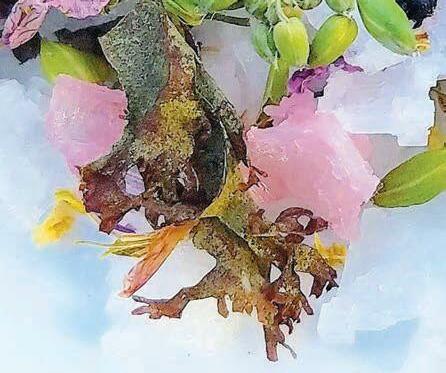



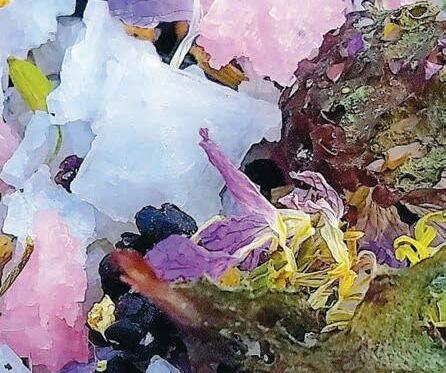
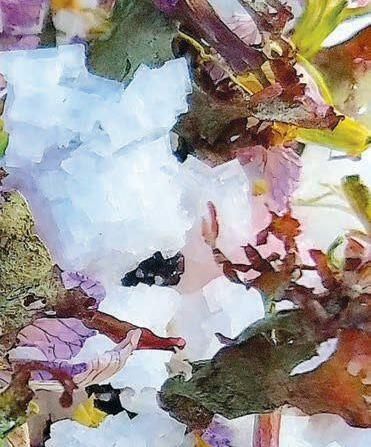







® BIG SUR SALTS • TRASH FISH CSAS • M.F.K. FISHER • CHÈVRE Celebrating the Local Food and Drink of Santa Cruz, Monterey and San Benito Counties Spring 2018 • Number 27 Member of Edible Communities edible MONTEREY BAY
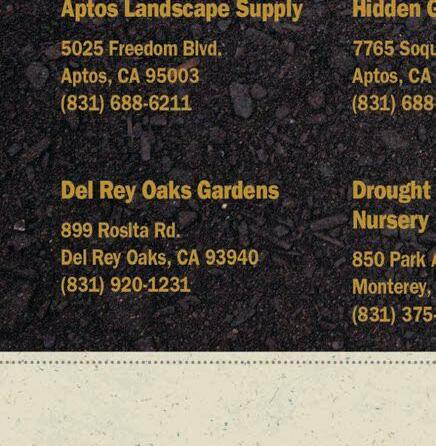
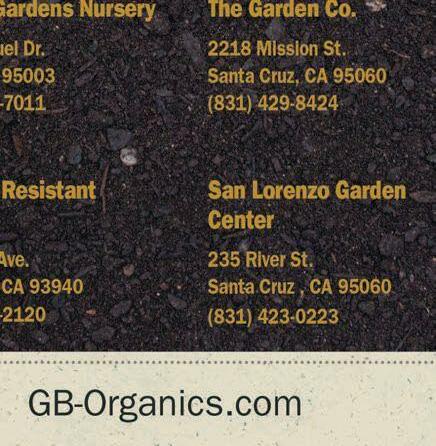

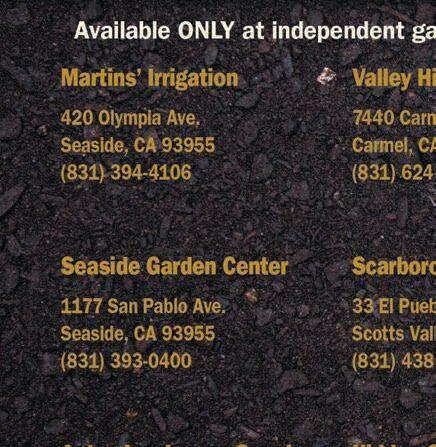
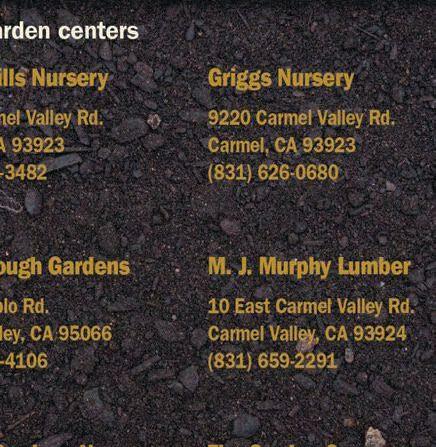
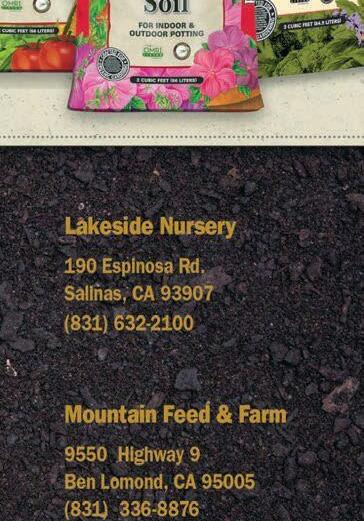

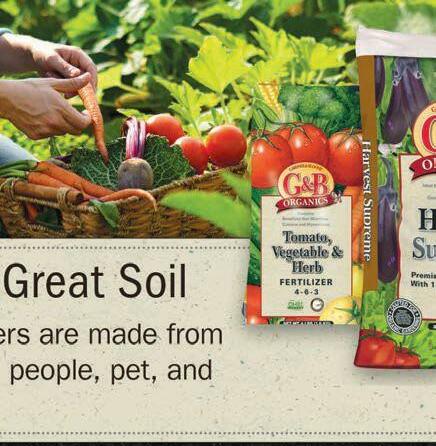


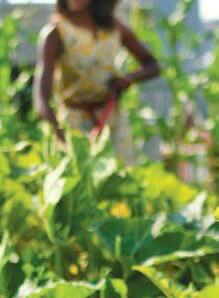


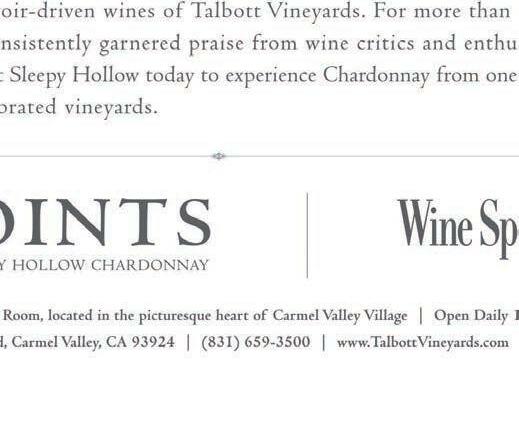



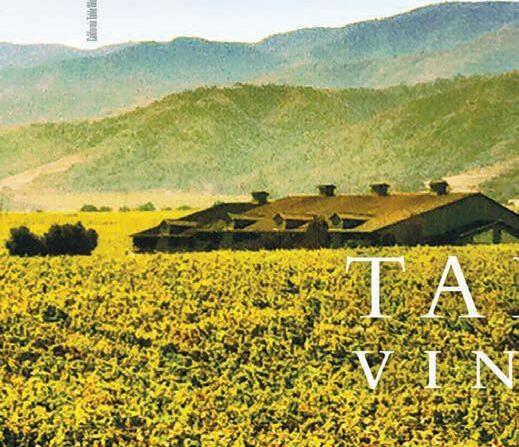
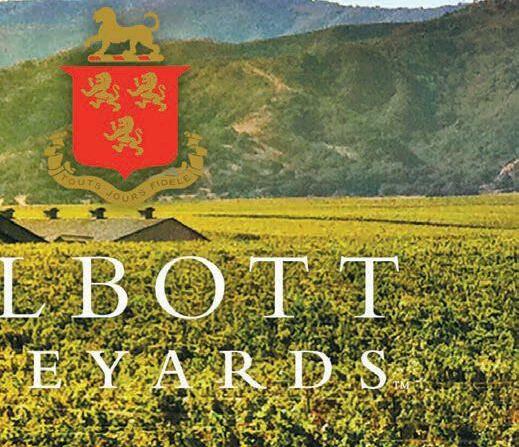
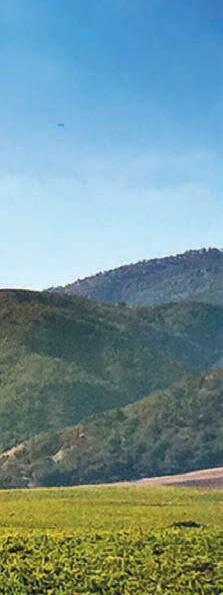


EDIBLE NOTABLES
Why collaboration and not competition is the mantra of local craft breweries; how legalization has brought boom and bust for local artisan producers of edible marijuana products
WHAT’S IN SEASON ASPARAGUS
If you love fresh, local asparagus, you might want to start growing your own
EDIBLE ICONS M.F.K. FISHER AND ME
How bad dorm food led to an unlikely nine-year culinary correspondence with a legendary food writer
ON THE FARM KNOW YOUR FARMER
As organic food becomes more widely available, CSAs struggle to survive
THE PRESERVATIONIST MAKING GOAT CHEESE
Transforming milk to chèvre with the help of some inspiring local goat herders

RECIPES IN THIS ISSUE
17 Monterey Bay King Salmon with Asparagus and Spring Vegetables 18 Asparagus Risotto
18 Valley Kitchen Spring Asparagus Purée
39 Local Vermilion Rockfish in Pink Peppercorn-Salt Crust 52 Chèvre
More online at www.ediblemontereybay.com/recipes:
• Crispy Garbanzo Battered Romanesco
• Ginger Brined Grenadier with Parsnip Purée, Bacon Beurre Blanc and Apricot Sweet and Sour Glaze
A complete guide for the Monterey Bay area

A local man risks life and limb to make seriously inspired salts
ON THE HOOK TRASH TALK
Why so-called trash fish are actually a secret treasure—and why it matters
An illustrated guide to enjoying the fruits of spring

COVER PHOTOGRAPH





Big Sur Salts’ Laguna blend by Carlo Overhulser
CONTENTS PHOTOGRAPH
Sheep at Garden Variety Cheese’s Monkeyflower Ranch by Julie Cahill




2 edible MONTEREY BAY SPRING 2018 4
GRIST FOR THE MILL 6
12
23
FOODSHED SPRING FARMERS’ MARKETS
26 SPRING FORAGING CLIFF CLIMBER
32
40
44
50
53 DINE LOCAL GUIDE 67 LOCAL SOURCE GUIDE 72 LAST CALL DECIPHERING DESSERT
Contents




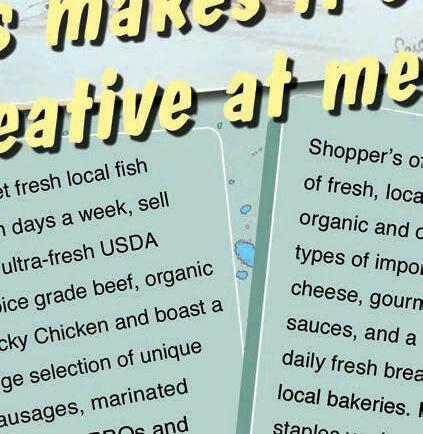




GRIST FOR THE MILL
“It seems to me that our three basic needs, for food and security and love, are so mixed and mingled and entwined that we cannot straightly think of one without the others. So it happens that when I write of hunger, I am really writing about love and the hunger for it, and warmth and the love of it and the hunger for it. And then the warmth and richness and fine reality of hunger satisfied…and it is all one.”
—M.F.K. Fisher, from e Gastronomical Me
As we write this note, the United States is reeling from its latest school shooting, which, at the time of this writing, was in Parkland, Fla. You may wonder, “But what does that have to do with food? Edible Monterey Bay is a food magazine!” is is indeed a food magazine. But as M.F.K. Fisher so artfully expresses in the above passage, food, security and love are all connected. And knowing this, it’s our profound hope that in the near future we all can come together to demand badly needed, common-sense gun regulation, just as we have rallied around safe and healthy food. Our children depend upon both. But back to this issue, Fisher’s comment comes from a beautiful story by our writer, Anina Marcus, about her long correspondence with the legendary author and what she learned from it. Indeed, you’ll find much throughout the magazine to help you celebrate and provide the food, love—and even the security—of which Fisher writes.
John Cox’s piece tells the fascinating story of so-called trash fish—the undervalued, less familiar and yet abundant and delicious species that are so important to the livelihood of our local fishermen and the revival of our local fisheries. We also include an illustrated guide to local “trash fish” and Cox’s professional tips for preparing them.
Kathryn McKenzie writes about the struggles our region’s vibrant CSAs are having as they face increasing competition from big box stores, conventional grocers and prepared meal companies, and her story may make you decide to provide a little more security to a farmer—and a little more super-fresh food for you table—with a CSA membership. Our CSA guide will help you choose the right one for your household.
Rosie Parker takes you foraging with the founder of Big Sur Salts, who has been bringing a lot of love to the kitchens of local chefs and home cooks alike with sea salts and sea salt blends like the one on our cover.
Other stories that you’ll not want to miss include Jordan Champagne’s instruction in making your own chèvre and Jamie Collins’ piece (with recipes from Tim Wood) on that quintessential harbinger of spring, asparagus. In something of a sequel to our story last year about how marijuana legalization was affecting the region’s agricultural community, Wallace Baine checks in on local pioneers of the cannabis edibles business. And finally, Lily Stoicheff explores the latest collaborations of our refreshingly collegial brewery community.
But whatever you do, be sure to read Marcus’ story about Fisher. It will stay with you for a long time to come, like the memory of a delicious meal shared with someone you love.
Cheers to a happy and healthy spring, Sarah Wood and Rob Fisher

Publishers
MONTEREY BAY
PUBLISHER AND EDITOR Sarah Wood
Sarah@ediblemontereybay.com 831.298.7117 or 831.238.1217
CO–PUBLISHER AND ASSOCIATE EDITOR Rob Fisher

DEPUTY AND DIGITAL EDITOR Deborah Luhrman
COPY EDITOR Doresa Banning
LAYOUT DESIGN Melissa Petersen
EDITORIAL ASSISTANT AND EVENTS MANAGER Rosie Parker
AD DESIGN Dina Clark
Bigfish Smallpond Design • Jane Bolling Design
Zephyr Pfotenhauer • Marilet Pretorius Melissa oeny Designs

CONTRIBUTORS Wallace Baine • Brock Bill
Crystal Birns • Julie Cahill • Jordan Champagne
Jamie Collins • John Cox • Bambi Edlund
Paul Fusco • Larry Gerbrandt
Margaux Gibbons • Rebecca Gourevitch
Ted Holladay • Michelle Magdalena
Anina Marcus • Kathryn McKenzie
Rosie Parker • Zephyr Pfotenhauer
Lily Stoicheff • Jake omas • Carole Topalian Patrick Tregenza • Amber Turpin • Patrice Ward
ADVERTISING SALES
ads@ediblemontereybay.com • 831.238.1217
Shelby Lambert shelby@ediblemontereybay.com Kate Robbins kate@ediblemontereybay.com Sarah Wood sarah@ediblemontereybay.com
DISTRIBUTION
Mick Freeman • 831.419.2875


CONTACT US: Edible Monterey Bay P.O. Box 228 Carmel Valley, CA 93924 www.ediblemontereybay.com 831.298.7117 or 831.238.1217 info@ediblemontereybay.com
Edible Monterey Bay is published quarterly. All rights reserved. No part of this publication may be used without written permission of the publisher. Subscriptions are $28 per year at www.ediblemontereybay.com. Every effort is made to avoid errors, misspellings and omissions. If, however, an error comes to your attention, please accept our apologies and notify us. We also welcome letters to the above address. ank you.
4 edible MONTEREY BAYSPRING 2018
Photo by Michelle Magdalena
edible












EDIBLE NOTABLES BETTER TOGETHER
Why collaboration and not competition is the mantra of local craft breweries






 BY LILY STOICHEFF
BY LILY STOICHEFF
Cold hands wrapped around hot mugs of coffee as brewers from 12 craft breweries from Santa Cruz, Monterey and San Benito counties crowded around the towering steel mash tuns and fermenters at Discretion Brewing in Soquel. Smiles easily thawed the chill as malted grain was crushed, water boiled, temperatures tracked. ese beer folks hadn’t seen each other in a while and were happy to take a rare break from their own breweries to work collectively to create a beer that would represent the Monterey Bay area.
Inspired by local waves and boardwalk treats like salt water taffy and candy apples, members of the new Monterey Bay Brewers Guild decided to make a salted caramel stout. Discretion hosted the event, Alec Stefansky from Uncommon Brewers offered homemade caramel, J.C. Hill from Alvarado Street Brewing contributed barrels to age it in and everyone lent a hand, enjoying the festive atmosphere and company of like minds.
is collaboration brew was one of five made in the region to mark the San Francisco Brewers Guild’s creation of five new geo-
6 edible MONTEREY BAYSPRING 2018
Photo by Brock Bill
Celebration: Brewers Tim Clifford and J.C. Hill (bottom right) and their crews from Sante Adairius and Alvarado Street breweries toast the second batch of their collaboration beer, 38 Miles.
graphically defined chapters—San Francisco, East Bay, North Bay, South Bay and Santa Cruz/Monterey Bay. To celebrate, each of the new guilds created a beer to represent itself at the 2018 SF Beer Week opening gala in February.
e gathering at Discretion was not the first time brewers in our area have come together there for a large collaboration brew. Last summer, eleven Santa Cruz County breweries and Venus Spirits cooperated on the “Brewers Unite for David” session IPA. Sales of the beer raised more than $10,000 for brewer David Purgason’s medical treatments after he suffered a serious work accident.
Despite increasing competition, the craft beer industry, seemingly tethered to its homebrewing roots, has embraced the spirit of cooperation, and breweries frequently and willingly share knowledge and equipment in a remarkably supportive environment. Collaboration brews—the result of two or more breweries working together to create, brew and release a beer together—are the drinkable manifestation of this fraternal spirit.
While large-scale collaborations allow brewers to share information, discuss process and equipment and learn from each other, one of the biggest benefits is just getting everyone together. “It seems like a pain to coordinate, but when people are here, it’s really fun to talk to all these brewery owners and brewers. We all like each other and are all so busy trying to run our own breweries that we don’t see each other that often,” says Dustin Vereker, co-owner of Discretion Brewing.
To Discretion’s head brewer Michael Demers, sharing knowledge and even ingredients is the industry norm. He says, “In a way, we have an ongoing collaboration, because I got calls today from two breweries and a distillery asking to borrow ingredients, and we do that too. ey say, ‘I’m short on this, do you have any extra?’ We’re doing that all the time.”
While the growing number of local breweries is competing for tap handles, customers and shelf space, it doesn’t yet appear to have damaged this sense of fellowship. Says Vereker, “So far it seems like we can continue to add new breweries and it’s okay. ere’s still a feeling of respect and that you can actually love your competitor.”
More craft breweries exist in America today than at any other time in history, and California—with more than 900—has the most. Like the rest of the state, the Monterey Bay area has seen a precipitous rise in craft brewing in the last 10 years, with at least 20 breweries now in operation and a couple more due to open this year.
Surprisingly, the impetus for the first collaboration beer wasn’t friendship—it was coincidence. In 2006, Santa Rosa’s Russian River Brewing and Boulder’s Avery Brewing realized they both had beers called Salvation. Rather than duke it out over naming rights, they
blended their respective beers and Collaboration not Litigation Ale was born. Since then, the number of collaboration brews has skyrocketed nationally, and our area is no exception.

What is the allure of this process? Consumer popularity is certainly one factor. In an industry where the exclusivity of the product is almost as important to the consumer as taste, the desirability among craft beer aficionados for these rarer mind-melds is high. But according to local brewers, the true value of this process lies in the ability to nurture relationships, share knowledge and engender creativity while creating a product that is, ideally, greater than what each brewery could come up with on its own.
For head brewer Hill of Alvarado Street Brewery in Monterey, teaming up with the brewers of Capitola-based Sante Adairius Rustic Ales, whom he had long admired, was a “pinch me” moment. At Hill’s invitation, Sante Adairius and Alvarado made two beers together in 2016 and named them after the distance between the two breweries: 38 Miles, a hoppy, hazy IPA released in a can; and 64 Kilometers, a barrel-aged mixed fermentation saison. e Sante Adairius team joined the Alvarado brewers at their facility in Salinas for a full day of brewing—an experience that Hill feels solidified their friendship and made them want to brew a second batch of 38 Miles in 2017, to coincide with the release of 64 Kilometers.
“Brewing is such a passion-driven industry. We all benefit from that synergy of putting our heads together and seeing what will happen,” says Hill. “It’s so cool to see how someone approaches a beer from inception to creation.”
Business partners Tim Clifford and Adair Paterno of Sante Adairius have fond memories of that brew as well, which they say was born out of mutual respect for the others’ skills and a willingness to share information. “Trading ideas, sharing ideas, challenging each other based on those ideas—all of those are opportunities for growth,” says Clifford.
Beer drinkers went nuts to try the brainchild of nationally acclaimed Sante Adairius and up-and-coming Alvarado, and 38 Miles sold out in a few hours. While both breweries were understandably pleased, they emphasize that the true measure of success is non-material.
“Marketing should never be the purpose. It’s an indirect effect, but we’ll never do one solely for that purpose,” says Hill, who has also collaborated with Santa Cruz’s Humble Sea Brewing Co. “Collaboration brews are a really personal experience.”
Clifford agrees. “e goal is to make something in which we learn collectively, and hopefully we make something in a Voltron kind of sense, bigger than each of ourselves. As long as that’s the intention, then it’s great.”

www.ediblemontereybay.com 7
Photo by Dustin Vereker
Paterno says that even as it has grown, craft beer is still the most collaborative industry she’s ever been involved in. “ere aren’t that many industries where people are willing to literally share their secrets with their competitors.”
She believes one reason for this is that craft breweries share a common foe—macrobreweries, the largest being Anheuser-Busch InBev, which owns more than 200 national and international brands including Budweiser, Corona and Michelob. “e smaller breweries have always banded against that, and that’s been common throughout our industry. It’s us against them,” says Hill.
As a result, craft brewing has become very “open book.” “Everything that we’ve done is something that I’ve learned from another brewery along the way. e reason we’re here is because of that collaborative nature. Bud and Miller have so much power. It’s easy to see why the little guys banded together,” he says.

Without the support and advice of Santa Cruz Mountain Brewing co-owners Emily omas and Chad Brill, Brewery Twenty Five in San Juan Bautista might have remained a twinkle in the eyes of owners Fran and Sean Fitzharris. Over the years the couple became good friends with omas and Brill, and eventually consulted with them about how to open a brewery of their own. When the time came for SCMB to upgrade its brewing system, it sold its used equipment to the Fitzharrises to help get Brewery Twenty Five off the ground.

“We had already decided that if and when we do a collaboration, it has to be with Santa Cruz Mountain Brewing,” says Fran. “In my experience, collaborations are either the celebration of a friendship or the launch of a future friendship. is one is definitely the celebration of a longtime friendship.”

For their collaboration, the two breweries decided to embark on a yeast-driven experiment, dividing a jointly brewed batch of Flanders red ale into four barrels. Each person added a different yeast of their choosing into one barrel, and waited, aging the beer for two years.
“e results were great,” says omas. “Each beer was unique and wonderful, and we were able to document the subtle and sometimes not so subtle nuances among the beers.” All self-proclaimed “dog people,” the four brewers gave their beers the names of their beloved pups—Max, Jake, Charlie and Pete.
In addition to celebrating a supportive friendship, releasing the beer with the established SCMB exposed Brewery Twenty Five to many new potential customers.

Looking back, omas says she believes brewing has always been a very cooperative industry. “We aren’t competitive with each other because our true competition is the monolithic beer producers and their intent to control independent craft brewers. For 13 years, I can’t remember a single time where a brewer didn’t share resources or information with SCMB. Likewise, I always want to pay it forward.”
Lily Stoicheff is an eater and writer living in Santa Cruz. A craft beer and fermentation hobbyist, her house is overflowing with jars of things that look gross but she swears are delicious.

8 edible MONTEREY BAYSPRING 2018
Legalization

EDIBLE NOTABLES CANNABIS MEETS CAPITALISM
has brought boom and bust for local artisan producers of edible marijuana products

 BY WALLACE BAINE PHOTOGRAPHY BY REBECCA GOUREVITCH AND JAKE THOMAS
BY WALLACE BAINE PHOTOGRAPHY BY REBECCA GOUREVITCH AND JAKE THOMAS
Maybe one day in the near or distant future, when Taylor Swift is running for president and California joins the United Nations, your marijuana dispensary will look a lot like your local Safeway, only with better in-store music.
Maybe then cannabis edibles will finally achieve full market penetration and you’ll be able to buy dosed versions of everything from breakfast cereal to crab dip, or choose between 36 varieties of pot brownies. But that paradise of consumer choice is not here yet. It did not suddenly materialize with the passage of Proposition 64 in 2016— which allowed for the legal use of marijuana for adults in California— nor with its implementation on New Year’s Day 2018.
If future growth in cannabis consumption is in food products— as opposed to smoking or vape products—then today we are witnessing a baby-steps stage in a market that may soon be unrecognizable. ere are edibles available now, but the quality and variety are necessarily limited by the brave new world of legalization. Everyone in the

cannabis industry—growers, manufacturers, entrepreneurs, consumers—is learning about the emerging norms and standards where weed meets capitalism.

Today, you can buy, through licensed dispensaries, a number of cannabis-infused foods including chocolates, candies, cookies, gummies, juices and truffles. Many such products have been around for years, serving the medical marijuana market first established by Proposition 215 in 1996. But the new recreational market is much more heavily taxed and regulated than the medical market was. As a practical matter, that means many products available to medical users are no longer on the market. Others are still available, but more expensive.
“ere’s not a lot of things available,” says journalist Christopher Carr who has been chronicling the Santa Cruz cannabis industry on his KSCO radio show e Cannabis Connection. “e majority of edible operators are not licensed. Only the most successful and established companies were able to get that paperwork prior to January 1.”

www.ediblemontereybay.com 9




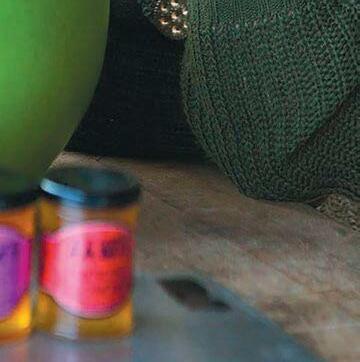


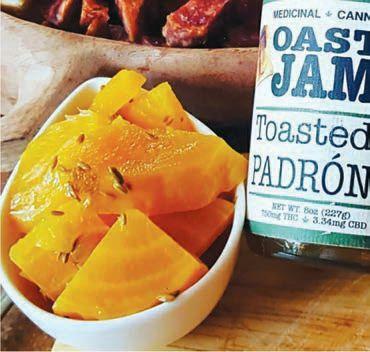
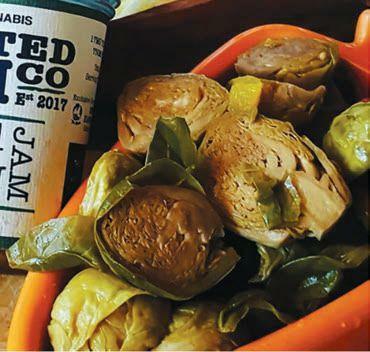
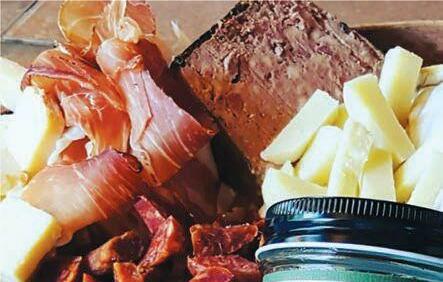
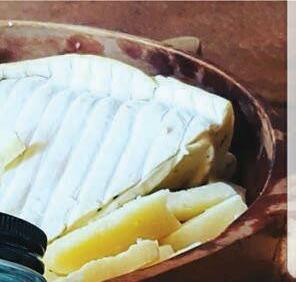
10 edible MONTEREY BAYSPRING 2018
Photo of Stroup by Jake omas; others by Rebecca Gourevitch
“I’m pretty sure this is the only instance in my lifetime that we’re witnessing a brand new industry in its infancy.”
—Tabitha Stroup
“Lots and lots of good people who have done nothing wrong are not going to make it.”
—Ben Rice
One of those established companies is Santa Cruz-based Big Pete’s Treats, which makes and sells cannabis-infused cookies—chocolate chip, peanut butter, cinnamon sugar and lemon. According to CEO Pete Feurtado Jr. (son of the company’s namesake founder), Big Pete’s cookies are available in close to 200 outlets all over California.
Big Pete’s operates from a small industrial kitchen on the east side of Santa Cruz, a stone’s throw away from perpetually clogged Highway 1, with about a dozen employees including bakers, distributors and office personnel. Since January 1, business has been brisk, says Pete Jr. (aka “Little Pete”). “At the first of the year, orders came in so fast, we had to add a second shift.”
e company’s ambition is to become something like the Famous Amos of the cannabis cookie business. Its creation story centers on Pete Feurtado Sr. and his early experiments in baking with weed back in 1979, when legalization was a distant dream. It was a couple of decades later, after the passage of Prop. 215, that Pete Sr. resharpened his baking skills and attended Oaksterdam University, the Oakland-based institution that calls itself “America’s first cannabis college.” Soon, he had perfected a recipe for cannabis-infused butter that is still the special sauce in Big Pete’s cookies.

But the company still had to figure out the dosing issue. Pete Jr. remembers that first attempt at making snickerdoodles with his dad’s infused butter. “at was the strongest batch of cookies we ever made,” he says. “We were watching a football game or something, and we all ate a cookie. Two hours later, we were all napping on the couch. We had no idea what the right dose was.”
e body absorbs cannabis through digestion differently than it does through the lungs and, as a result, the psychoactive properties are also different. Typically, the high is slower to arrive and often lasts longer. In the new world of legal weed, edibles producers and consumers are having to learn about how to eat cannabis.

Big Pete’s Treats soon figured out the optimum dosage and now sells its mini cookies with 10 milligrams of THC per cookie, which Pete Jr. likens to smoking a single joint. (I tried one of Big Pete’s peanut butter cookies—only in the interests of professionalism, mind you— and found it packed a punch. Individuals will have different tolerances; some people won’t feel a blip at 10 mg, but my own constitution has now taught me not to have more than one in a single sitting.)
us far, Big Pete’s is a success story in the cannabis edibles market, but many other would-be edibles producers are finding the new regulations, fees and taxes prohibitive. Soquel-based Friend in Cheeses Jam Co. has built a strong national brand in artisanal jams—favorite flavors include Salted Watermelon and Pisco Pear. In 2017, the company sold a cannabis-infused line called Toasted Jam Co. in about 100 dispensaries across the state. But the new taxes and regulations imposed by Prop. 64 have effectively pushed Toasted Jam off the market. To continue in the new recreational market, Friend in Cheeses jam maker Tabitha Stroup says her company would have to pay up to 10 times more in production costs for new security measures, kitchen retrofitting, insurance and certification.
“It closes a lot of doors for small producers like myself,” says Stroup, who added that she is interested in selling the Toasted Jam line to someone willing to commit the necessary capital investment. “But that doesn’t mean it can’t change and get better because I’m pretty sure this is the only instance in my lifetime that we’re witnessing a brand new industry in its infancy.”
“Lots and lots of good people who have done nothing wrong are not going to make it and that sucks,” says Santa Cruz attorney Ben Rice, who has been at the center of the legal thicket in the California cannabis movement. But Rice is optimistic that a wider and more diverse market in edibles will emerge in time. Governments are also learning, he says, about the right level of licensing, taxation and regulation needed to keep the black market at bay and allow entrepreneurs to flourish, while protecting the public. Legal weed is very much an unfinished experiment.
“ere will be more options for people as time goes by, and there will be more enthusiasm for those various goods,” says Rice, who sees legal weed’s current status as an uncertain period of experimentation and growing pains. “When people learn to use the appropriate amounts, they’re going to have a lot more fun.”
Wallace Baine was a columnist, critic and arts/culture writer for the Santa Cruz Sentinel for 26 years. He is the author of four books, and the founder and host of the annual Gail Rich Awards for artistic excellence in Santa Cruz County. He is not entirely unfamiliar with cannabis consumption.

Cannabis cooks: pg. 9, Pete Feurtado Jr. and Sr. of Big Pete’s Treats; pg. 10, Tabitha Stroup of Toasted Jam and Friend in Cheese Jam Cos.

www.ediblemontereybay.com 11
WHAT’S IN SEASON ASPARAGUS
If you love fresh, local asparagus, you might want to start growing your own
BY JAMIE COLLINS PHOTOGRAPHY BY PATRICK TREGENZA
Elegant asparagus—often called the king of vegetables—has long been considered a sure sign of spring, but cultivation of the delicate green spears here in California has declined sharply due to labor costs and the huge amount of land required to grow it. Farmers’ market favorite HOG Farms stopped growing asparagus this year, but a few other growers are stepping up to fill the gap. And it is well worth seeking out locally grown, in-season asparagus—because the taste can’t be beat.
Asparagus, or “grass” as it’s called in the produce industry, is in the lily family. In order to have a continuous supply from January to June, it is grown in three main areas of California—the Sacramento River Delta, the San Joaquin Valley and the Central Coast. Our local harvest takes place between March and June mainly in Monterey and San Benito counties.
Cultivated around the world for thousands of years, asparagus is very adaptable to various growing conditions, but takes several years to produce the thick stalks that people love. It can be grown from seed, but takes a year to grow a seedling into a crown that can be planted. Once the crown is planted, it is another long wait—three years of weeding and tending to the crowns before they grow into the fat spears that are quickly snapped up at the spring farmers’ markets. ese crowns produce high-quality harvests for another three to four seasons before they begin to decline. At any given time the grower must have half his land in an unproductive state, which is tough when land leases can be extremely costly in our neck of the woods. is is one reason acreage of asparagus in California has been declining steadily; currently there are about 10,000 acres in production, down from 40,000 in 2000.
Ray Franscioni of HOG Farms—which stands for Hollister Organically Grown—this year stopped growing the asparagus crop I have enjoyed and purchased for many years at the Santa Cruz Community Farmers’ Markets.
“California labor laws, regulations and restrictions make the cost of labor too high to make sense to grow asparagus here,” he explains. “Local growers are moving operations to Mexico where labor is 15–20% of the crop cost and land is cheaper. We couldn’t compete with Mexico to grow the crop and we have no plans to farm down there. I love asparagus and I won’t mind paying 5 bucks a bunch at the store when I want some.”
HOG Farms currently grows 3,500 acres of row crops and 1,500 acres of wine grapes, and Franscioni is focusing on row crops that can be mechanized like spring mix or those that need only one person to run a machine. He says even the harvesting of head lettuce is very close
to being completely mechanized as the lettuce heads are uniformly sized.
Asparagus spears, by contrast, must be harvested by hand and then hand-sorted into different sized bunches that are set precisely by the California Asparagus Commission. First fieldworkers cut them at the base of the stalk with a sharp knife and toss them into a basket strapped to their waist. e baskets are emptied into bins, which are taken to a packing shed where the asparagus are rinsed, trimmed, sorted by size and packed into neat bundles. Size depends on the age of the plant— the youngest are the thinnest.
As you can imagine, having a crop in the ground for three years before it is harvested requires a lot of expensive weeding, especially if the asparagus stalks are organic and herbicides aren’t used. Tractor and hand weeding take place while waiting for the “green rush” in year three. In the old days, salt was used as an herbicide because asparagus can tolerate it. But farmers quickly realized it meant ruining the soil for other crops. An ingenious couple in Maine received a grant to see if their chickens could greatly reduce the amount of weeds in their asparagus field without damaging the plants. e project was very successful in reducing weeds without ruining the spears—they suggested eight to 10 chickens per 1,000 square feet. e chickens also benefited the asparagus by foraging for beetles that cause crop loss! However, with the new food safety regulations it is doubtful this practice will actually be used in commercial production.
GROWING ASPARAGUS
If you want to grow asparagus in your home garden, I highly recommend buying established one-year-old “crowns” and planting them in pots or raised beds. If not, the crowns will spread out and pop up all over the place, and you may not take care of them as well as if you have them contained and remember where they are planted. ey also don’t like soggy soil, which is harder to avoid when you plant them directly in the ground. Plant crowns in the spring and be sure to start with a thick layer of compost in the trench where you plant. Crowns should be planted 15 inches apart and covered with 2 inches of soil. As the stems grow, continue to fill the rest of the trench with soil, leaving only 3 to 4 inches of the stem, then add a 6-inch layer of mulch and water regularly. Try not to harvest young spears the first year, as they are providing food for the roots so they can make bigger spears in years to come, or else have a snacking section where growing full-sized spears is not the goal. Leave the fern-like foliage on the plant and cut it back
12 edible MONTEREY BAY SPRING 2018

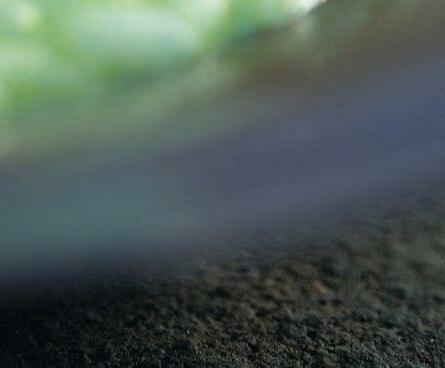

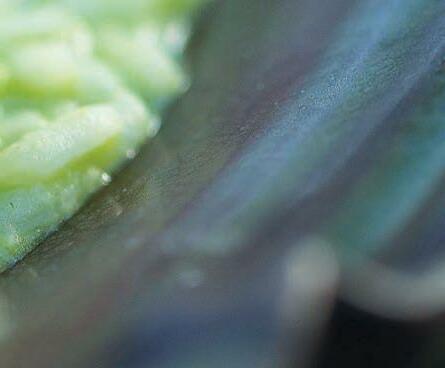


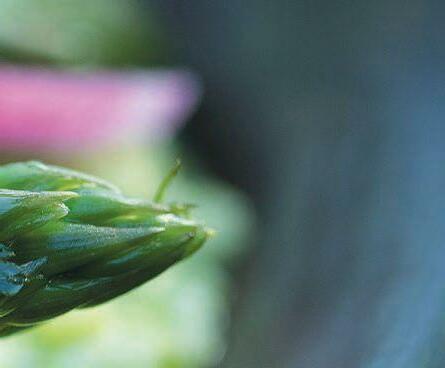
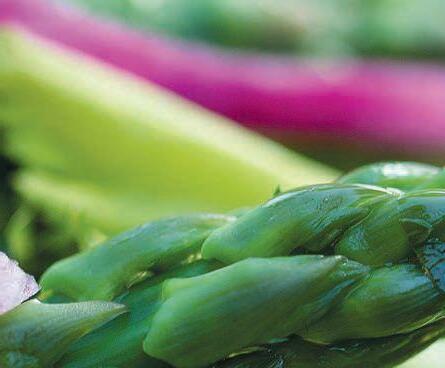




www.ediblemontereybay.com 13
“Having a crop in the ground for three years before it is harvested requires a lot of expensive weeding, especially if the asparagus stalks are organic and herbicides aren’t used.”
once it turns brown in the fall. Side dress with compost in the fall and repeat the above for year two, and so on. When stalks are 6 inches tall and the width of a pencil or larger, they can be harvested. Be sure to harvest daily, as spears can grow 6 to 10 inches in one day if the conditions are ideal. ey will continue to grow for a period of two to three weeks.

ird-generation Violini Farms has been growing asparagus for more than 45 years in Gonzales, which is ideal because the climate is so temperate. Both organic and conventional asparagus are grown and some is marketed under the label Coastal View Produce. eir fresh, crisp crop of organic grass can be found March through June at all of the Santa Cruz Community Farmers’ Markets except the downtown market, where L&J Farms out of Greenfield sells its organic crop. Bounty of the Valley Farm of Greenfield sells L&J’s organic asparagus for it at the Old Monterey Farmers’ Market on Tuesdays and the Carmel market on ursdays. Bounty of the Valley’s Matt Hayes began growing asparagus in 1986 but stopped in 2013: “You have to ‘touch’ asparagus 10 times before it gets onto the market tables; it is very labor intensive,” Hayes says.
HOW TO CHOOSE AND STORE ASPARAGUS
Look for blemish-free spears with tightly closed tips and rigid-looking stems; avoid wilted stalks. Cut off the ends and store them upright in cold water in the fridge if possible, or cut and wrap the ends with wet paper towels and place in a plastic bag in the refrigerator. Cut the last few inches off the spears right before you cook them and for the best flavor, eat as soon as possible. e thick stems have more carbohydrates, therefore are sweeter when cooked. in versus fat asparagus is a personal preference, but both are tasty and full of fiber, vitamins C and K and folic acid as well as naturally low in calories.
TIPS FOR PREPARING ASPARAGUS
Roasting brings out a sweet, nutty flavor; simply coat with olive oil, salt and pepper, a little lemon zest and roast in the oven for 15 minutes. For salads, blanch then cut in bite-sized pieces. Or use a vegetable peeler to make thin strips of raw asparagus and use them in a salad or on top of a pizza. Pickled asparagus is also very good. Try it in risotto, like in the recipe provided here by Carmel Valley Ranch’s Tim Wood.
Jamie Collins is the owner of Serendipity Farms, which grows organic row crops in Santa Cruz and Monterey counties and distributes them through U-picks, farmers’ markets and a virtual farm stand, which can be found on Serendipity’s Virtual Farm Stand Facebook page.


RECIPES: See p. 17 and 18 for Carmel Valley Ranch executive chef Tim Wood’s Valley Kitchen Spring Asparagus Purée, Asparagus Risotto, and Monterey Bay King Salmon with Asparagus Purée.


14 edible MONTEREY BAYSPRING 2018
TIM WOOD: Cooking with the




Seasons
While growing up the youngest of three boys in the Hudson Valley, N.Y. hamlet of Stone Ridge, it was Tim Wood’s job to watch for and pick the tender asparagus tips after they began poking up through the hay the family had spread over its backyard crop the prior fall.
“It was a big deal. It’s still a big deal,” the executive chef at Carmel Valley Ranch’s Valley Kitchen says, referring to the anticipation of when the local asparagus and later, sweet corn, season would begin. To this day, asparagus and corn remain two of his favorite vegetables.
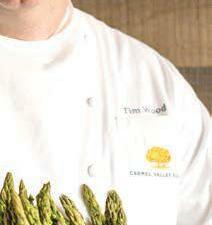

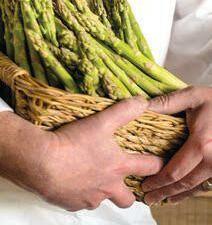

While many chefs only discover the myriad benefits of cooking with local, peak-of-season produce through culinary school, mentors or trial and error, eating with the seasons has always been Wood’s way of life.
“I never realized that not everybody had that,” he says, referring to his family’s 15-by-20-foot asparagus plot, and the opportunity he had to eat “really well-executed fresh food” at his family’s table. “We’d only pick what we needed that night.”
Today, Wood and his culinary team are able to shave over their soups freshly picked purple asparagus grown in their own organic garden, and Wood is trying to grow a new row of asparagus in the property’s vineyards for recipes like the ones that accompany this story. But daily shipments from Hollister’s Swank Farms are key to ensuring that the vegetables he cooks with are fresh-picked earlier the same day.

Wood began cooking professionally at age 13 (yes, he fudged his age) at a resort that was a half-hour bike ride from his home, and went on to train at the Culinary Institute of America in nearby Hyde Park, thinking that cooking would be a good skill to pay the bills while he launched an acting career.
But Wood never became an actor and says that his philosophy of cooking—which he shares prodigiously as a volunteer chef at community fundraisers—comes back to simply making food that tastes good, and checking his ego so that his ingredients can capture the spotlight. “I don’t want to cover up the brilliance of the ingredient,” he says. “I want to put it on as the star of the show.” —Sarah Wood
www.ediblemontereybay.com 15












16 edible MONTEREY BAYSPRING 2018
MONTEREY BAY KING SALMON WITH ASPARAGUS AND SPRING VEGETABLES
Courtesy Tim Wood, executive chef, Valley Kitchen at Carmel Valley Ranch Serves 6


One of our most important local ingredients is Monterey Bay king salmon. We are fortunate to have our own fisherman, Jerry Wetle, and his fleet of well-trained professionals who supply us twice a week with fresh local fish. I met Jerry on a fishing boat here in Monterey 17 years ago, and we have been working together like family. Jerry is featured on our menu at the Valley Kitchen with his line-caught fish of the day, which rotates based on seasonal availability.

My advice for where to purchase fresh fish would be to seek out a good market or your favorite restaurant, where you feel the quality is above par, and simply ask places they would recommend in the area. Not all chefs are willing to give up their secrets, but asking is a great start. As with many things in life, buying fish can be trial and error, but when you find an exceptional fish shop, it can make all the difference.
6 7-ounce filets Monterey Bay king salmon 2 pounds asparagus, blanched Spring vegetables, such as peas, green onions and mushrooms 1 bunch of thyme
Butter
Olive oil Salt and pepper Spring Asparagus Purée (see accompanying recipe)
Heat oven to 350° F. In a large heavy-bottomed sauté pan add olive oil, salt and pepper. Bring to medium/medium-high heat. Season fish with salt and pepper. Add fish to the pan in batches, allowing it to cook evenly without overcrowding, for 4 minutes on each side. Remove from pan and place in an ovenproof dish with a sprig of thyme and teaspoon of butter on each fillet and baste accordingly. Roast in oven for 3 to 6 minutes depending on thickness of fish. Prepare vegetables as desired.
To finish, pour the asparagus purée on a warm plate. Place salmon in the middle and place the warm vegetables and asparagus spears around it.
Chef Hack: Peel the bottom half of the asparagus with a vegetable peeler and blanch in salted, boiling water. Have ice bath ready to cool asparagus, so it does not overcook.
www.ediblemontereybay.com 17
ASPARAGUS RISOTTO
Courtesy Tim Wood, executive chef, Valley Kitchen at Carmel Valley Ranch Serves 8 to 10









1 large onion, finely diced (same size as grains of rice) 1 pound Arborio rice
1 cup white wine (Chardonnay)
Hot water or stock, simmering 3 tablespoons butter
1½ cups Parmigiano-Reggiano, grated
1 cup Spring Asparagus Purée (see accompanying recipe) Olive oil
Salt and pepper

Preheat a medium size, heavy-bottomed pot. Add a small amount of olive oil. Sauté onions until translucent. Add rice and stir until combined. Deglaze pot with the wine.
When the alcohol has cooked off, begin adding the liquid in small amounts, about a cup at a time. is much rice needs about 9 cups of liquid. When he’s at home and doesn’t have homemade stock to use, Wood uses filtered water, as he believes it’s better than using canned and he wants the asparagus to shine through anyways, but organic vegetable stock works well here. Continue stirring rice and test the doneness at intervals.
When the rice is cooked to your liking, add asparagus purée, butter and cheese. Season to taste with salt and pepper.
Should be creamy when finished.
Chef Hack: To make ahead, stop the cooking when rice is almost done. Spread rice on a cookie sheet and put in the refrigerator. When ready to serve, reheat by adding a cup of water. Add purée, butter, cheese and salt and pepper to finish.
Garnish with small, inside celery leaves and extra virgin olive oil, or radishes and pea shoots.
VALLEY KITCHEN SPRING ASPARAGUS PURÉE
Courtesy Tim Wood, executive chef, Valley Kitchen at Carmel Valley Ranch

Yields 6 to 8 3-ounce portions



is recipe is truly as simple as it looks. Mother Nature made the ratio easy to remember—one bunch of asparagus to one onion— and the keys to the purée’s success are simply the quality of the ingredients and the technique of sweating of the onions. Another beauty of the recipe is its versatility as a sauce, purée or a simple soup. For soup, adjust the consistency with more liquid, as desired; for a sauce or purée, less liquid is necessary. e pan used should be large enough to hold the asparagus and onion—a 2-quart saucepan with a heavy bottom to allow for even cooking should do.
1 pound fresh asparagus 1 medium onion 1 stick (4 ounces) sweet butter
Kosher salt Black pepper, freshly cracked Olive oil for cooking as needed Water or vegetable stock
Begin by cutting the onion in half from tip to root and removing outer skin. Slice the onion with a radial motion from top to bottom to keep consistent sizing. Ultimately you will end up with ¼-inch onion slices. In a heavy bottomed pot, start cooking the onions over low heat with a good amount of olive oil, about 2 ounces (¼ cup). Cook slowly to allow the bitter onion taste to sweat out and the onions to become sweet, about 25 minutes. Season with salt and pepper. is is always a good time to put together a salad or another part of your meal, but don’t wander too far off, as the onions could burn and make the pureé bitter.
While the onions are sweating, clean the asparagus by snapping the “woody” end off then chop into 1-inch pieces. is will allow the vegetable to cook evenly.
When the onions are soft and tender, take the chopped asparagus and add it to the onions. Cover the onion and asparagus mixture with enough water or vegetable stock to cover by about 1½ inches. Cook on a slow simmer until fork-tender (about 15 minutes).
Ready your blender or food processor and cut butter into small, manageable chunks. With a slotted spoon, take the solids from the pot and add to the blender in batches (about halfway up the blender) then add a half cup of the liquid from the pot to thin the mixture to desired sauce consistency. Add about 3 tablespoons of butter per batch for a texture that is rich and smooth. Repeat this process until all solids are blended. ere may be some of the stock left or it may be necessary to add some water to thin as you go. You can always thin your sauce down, but it’s hard to thicken if you add too much liquid.
18 edible MONTEREY BAYSPRING 2018
Photo this page by Carole Topalian











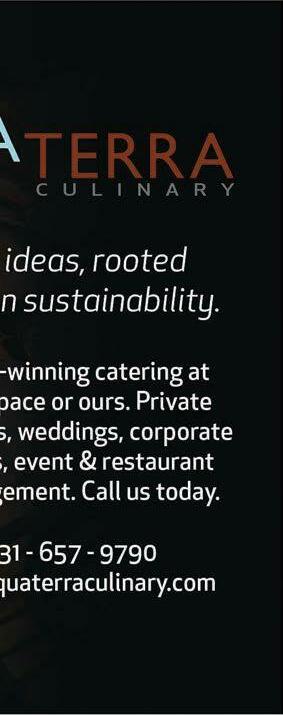






20 edible MONTEREY BAYSPRING 2018
FRUITS
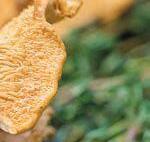
VEGETABLES


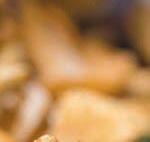





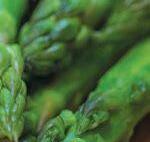
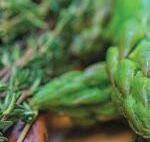

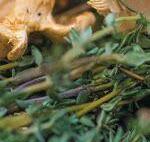
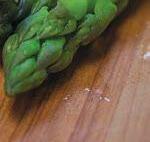
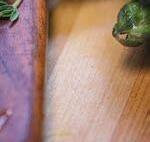
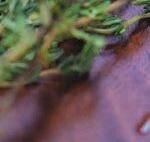
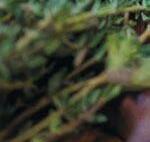



FISH

www.ediblemontereybay.com 21
Apricots* • Avocados • Blackberries* • Cactus Pears* • Grapefruit** • Kumquats** Lemons • Limes** • Mandarins** • Oranges • Pomelos** • Rhubarb** • Strawberries
Artichokes • Arugula • Asparagus • Beets • Bok Choy • Broccoli • Broccoli Raab Brussels Sprouts • Burdock • Cabbage • Cardoons • Carrots • Cauliflower Celeriac*** • Celery*** • Chard • Chicory • Collards • Cress • Dandelion • Endive Fava Beans and Greens • Fennel • Garlic • Horseradish • Kale • Kohlrabi • Leeks Mushrooms • Mustard Greens • Nettles • Onions • Orach • Parsnips • Peas** • Pea Shoots • Potatoes • Radishes • Rutabagas** • Shallots • Spinach • Sprouts • Squash Sunchokes • Turnips * May only ** March and April only ***April and May only
Abalone • Crab, Dungeness • Grenadier, Pacific • Halibut, California* • Lingcod, Pacific • Rock Cod, aka Snapper or Rockfish • Sablefish, aka Black Cod • Salmon, King Sanddabs, Pacific • Seabass, White • Sole (Dover and Petrale) • Spot Prawns • Squid All fish listed are rated “Best Choice” or “Good Alternative” by the Monterey Bay Aquarium’s Seafood Watch program and are found in abundance in local waters. See www.seafoodwatch.org for more information. *Halibut
the
assistance
by Real Good Fish and
Farms.
rated by
Marine Stewardship Council. Research
provided
Serendipity
LOCAL FOODS IN SEASON MARCH, APRIL, MAY










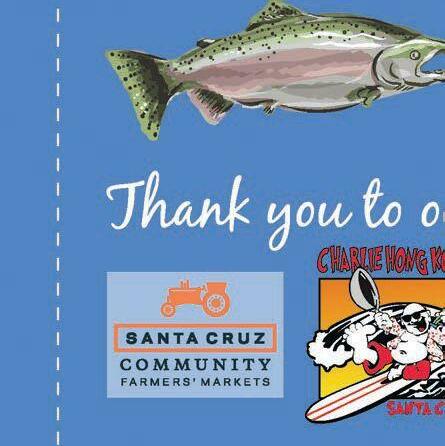
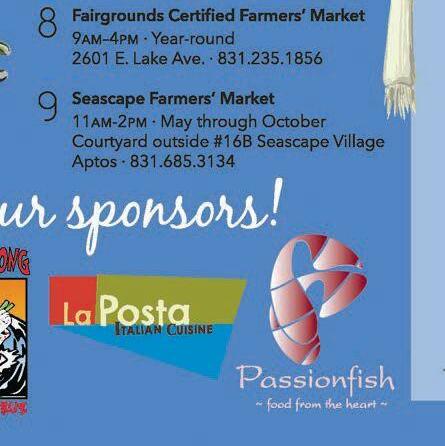

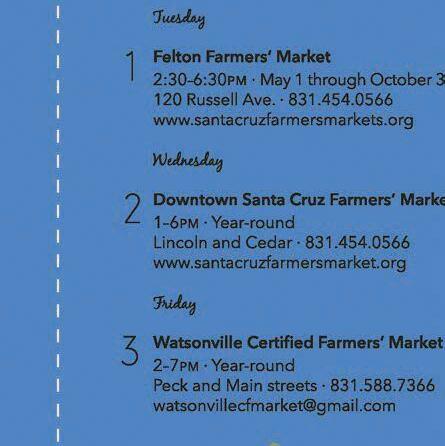

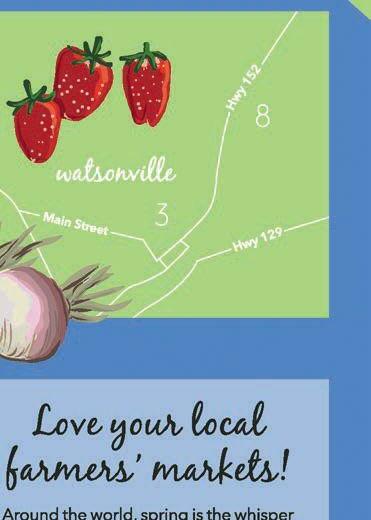

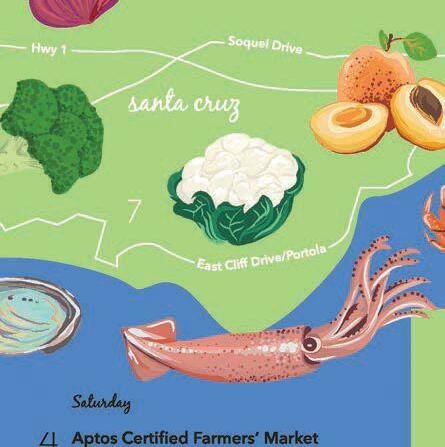




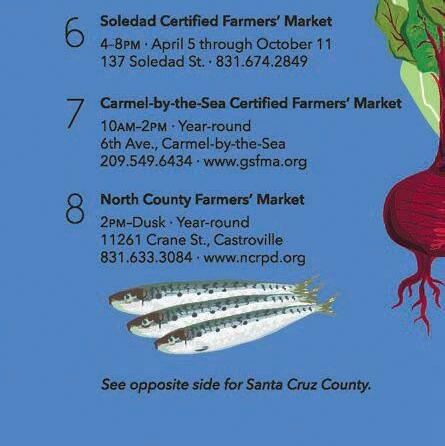
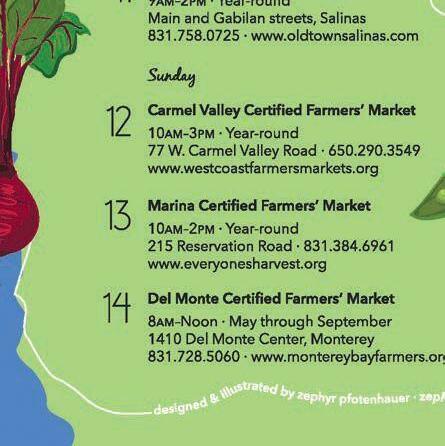

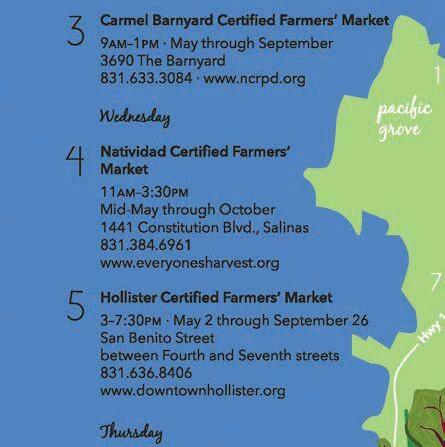
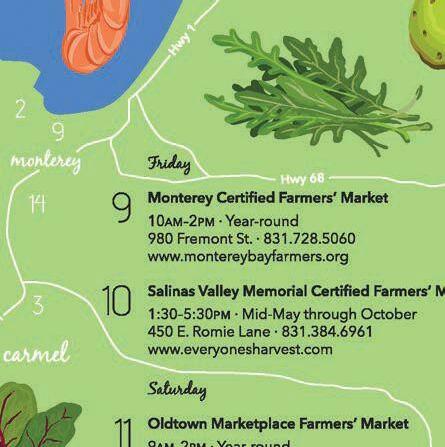




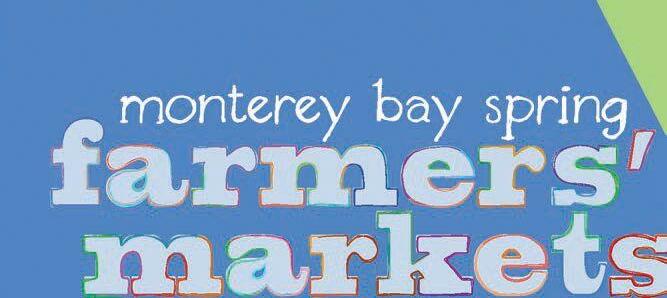







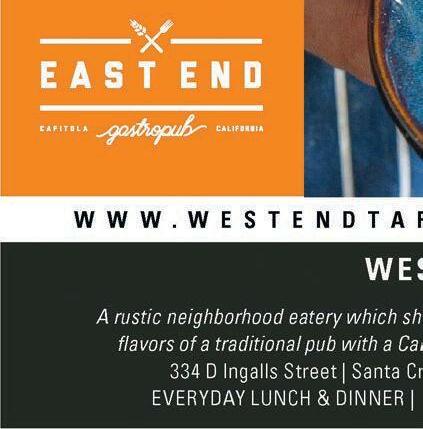
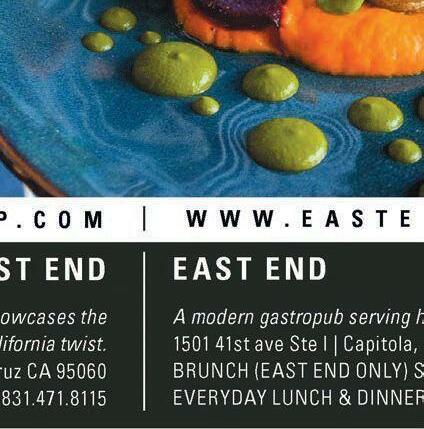
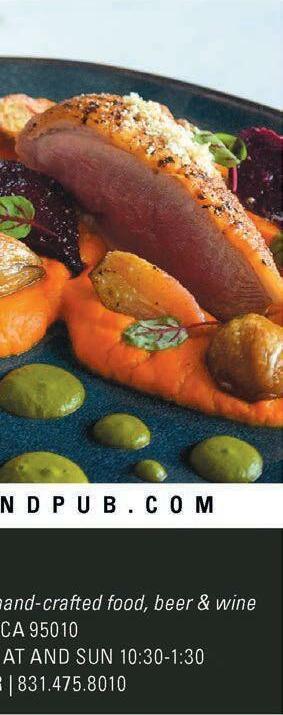

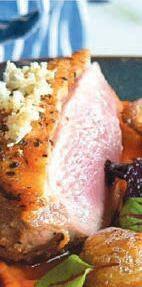
www.ediblemontereybay.com 25












26 edible MONTEREY BAYSPRING 2018
SPRING FORAGING CLIFF CLIMBER

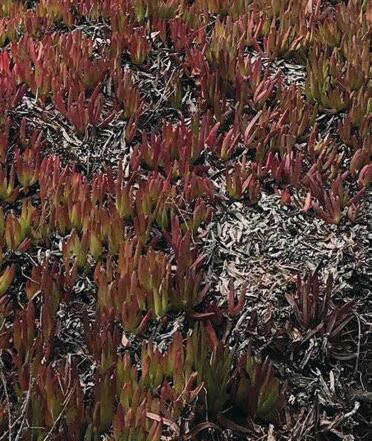
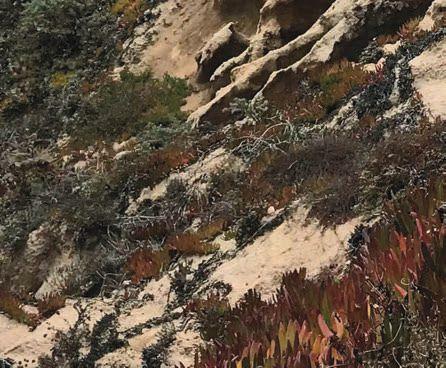
A local man risks life and limb to make seriously inspired salts
BY ROSIE PARKER PHOTOGRAPHY BY CRYSTAL BIRNS
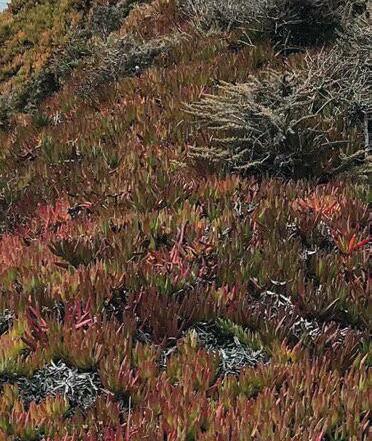
As the winter swells were starting to tower, Carlo Overhulser sat at the edge of a cliff near Las Piedras Canyon in Big Sur. He had been in a funk for some time—recently unemployed after the closure of a restaurant where he had been cooking and figuring out his next steps. It was November 2015 and from his home in Monterey he would venture down to Big Sur to hike, clear his head and enjoy a beer while perched on the rocks.



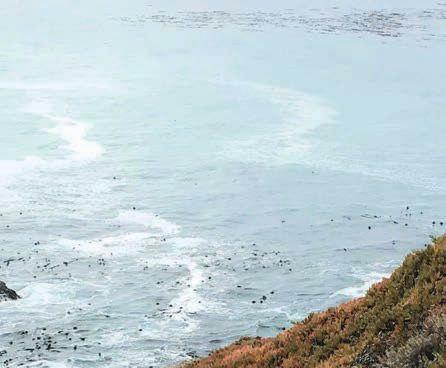

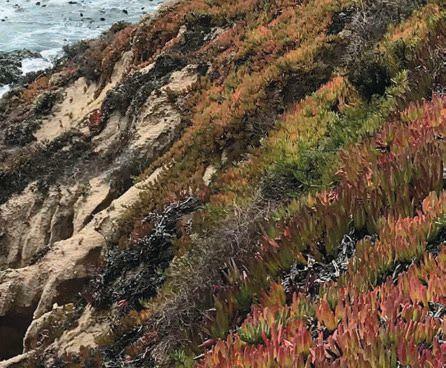
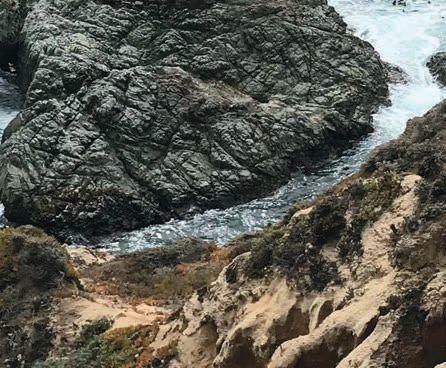
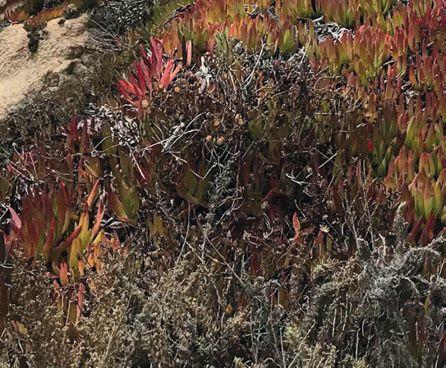
www.ediblemontereybay.com 27
e pools are all hidden down winding trails cut into the dramatic hillsides of Big Sur’s rugged coastline.
Watching the fishermen, lost in thought, Overhulser was too slow to dodge a massive wave that came up and completely washed over him, drenching him from head to toe. But he felt rejuvenated, as if the ocean was giving him a friendly smack in the face. He saved his beer bottle, by then full of seawater, as a memento. It was weeks later that he accidentally knocked over the bottle and found the water had evaporated and left behind a pile of salt crystals. “It sounds crazy,” he says with a laugh as he reflects on his company’s origins, “but since that day my entire life has been about salt.”
rough a process of trial and error, Overhulser started to build a business and by March of 2016 had established Big Sur Salts. To start, Overhulser—something of a renaissance man, having worked variously as a musician and sound engineer as well as a cook—conducted tests all over the Monterey Bay. Not surprising, the seawater from the pristine Big Sur coast was the highest in quality, with a purity and clarity akin to Himalayan sea salt. Harvesting in Big Sur also meant he could collect the seawater he needed to make his salts from the cliffs, avoiding the need to take a boat offshore a few miles to find similar quality.
Overhulser forages naturally crystalized salt from the cliffs, but the bulk of Big Sur Salts’ production comes from harvesting seawater and processing it in a commercial kitchen. In the beginning, this meant hiking down jagged rocks with a backpack full of beer growlers to fill up and then running back up to his truck, many times over. “I was just this lunatic standing out here with a growler tied to a PVC pipe,” Overhulser says. He was trying to figure out a legal and responsible way to harvest from the cliffs and coast when he discovered UC Davis’ Marine Pollution Studies Laboratory at Granite Canyon in Big Sur.
Since Granite Canyon already had a permit with the Monterey Bay National Marine Sanctuary, Overhulser was able to streamline his process by harvesting most of his water directly from the lab.
Every day, Granite Canyon takes in 50,000 gallons of water which it filters, tests and then expels back into sea. Overhulser goes down twice a week with two 55-gallon drums and draws water that has already been filtered three times. He adds an additional two layers of filtering before boiling it down to produce three styles of salt—fine, coarse and flake—most of which he transforms into fragrant and beautiful herbal blends.
“e blends began with foraging,” Overhulser explains. “I wanted to do everything as hyperlocal as possible. I strongly believe that what grows together goes together.” An early blend called Lily Valley, for example, contained salt, mustard flowers, wild radish flowers and chamise
all harvested from within 200 yards of each other. “Due to health regulations, the foraging of herbs and produce had to stop, but the concept is the same. I can source flowers, herbs and produce through local farms and get the same desired effect.”
Overhulser has produced about 45 different salt blends, some of which are exclusive to retail locations and businesses, like the blend he made for the Hyatt Carmel Highlands’ 100th anniversary party, which contained juniper berries, Spanish lavender and rosemary foraged from the resort’s property. “e inspiration comes largely from my environment and trying to capture the essence of Big Sur,” he says. Overhulser’s favorite blend, Old Coast Canyon, is named after the road that winds through canyons behind Big Sur. “Sage, leek, thyme, sour orange peel—when I smell this blend, I’m smelling the experience of that drive.”
ere’s also a series of what he calls “wild salt,” experimental blends infused with wine or liqueurs and even Burn Hot Sauce, for which salt is dissolved in the liquid and then dried again.
Blends and plain salt can be purchased at specialty shops and tasting rooms throughout the Monterey Bay area—Quail & Olive, Mountain Feed, Big Sur Bakery and Cima Collina—or from the recently launched Big Sur Salts online store. A 3.5-ounce jar is priced at $20, but with the strong aromatics and quality of the salt, a little goes a long way. My preferred blend, O-M-Chi, a harmonious combination of housemade kimchi, radishes, scallions, and Monterey Bay Seaweeds dulse, has found its way into all of my meals, one pinch at a time.
“I love the textures and colors and smells of all the blends. ey match the rugged landscape of Big Sur and allow me to showcase so many other amazing producers in the Monterey Bay,” he says.
SALT FORAGING
I met Overhulser at Monastery Beach in Carmel on a crisp October morning. e sea was calm and the sky was hazy from the recent wild fires to the north. We spent the morning traveling down the coast to forage at a few of his favorite locations. e cliff salt he harvests is entirely a passion project, a way to stay connected to the ruggedness and wildness of Big Sur. Harvesting approximately 300 pounds a year of wild salt, he eventually made the decision to not sell that product and instead give it to local chefs.
“e cliff salt belongs to us, the community,” he explains. “I’m not able to harvest enough to make a real profit off it, but it’s more than that. Nature gave us this. And it’s personal, it’s where everything started for me—it’s a huge part of the story of Big Sur Salts.”



28 edible MONTEREY BAYSPRING 2018
e optimal time to harvest cliff salt is during the coast’s warmer months—spring and fall. Spring harvests can be less labor intensive since the cliffs have had a season of large swells to fill up the pools carved into the rocks. roughout the summer months, if the swells are too small to fill the pools, Overhulser will manually fill them with buckets of saltwater he gets by climbing down the cliffs. If it’s a season of heavy rain or fog that dilutes the pools he’s monitoring, he’ll replace some of the water with harvested saltwater to help boost salinity.

Of the three locations we visited, only one was ready for harvest, and even then, Overhulser explained, it would be another two weeks until the pool had fully evaporated. We were able to collect 5 pounds of salt that day, whereas an optimal harvest would be 25 pounds from the same pool. Overhulser also explained that because we were pulling from the pool a little prematurely, we were mostly going to get flake salt. In a couple of weeks he would harvest a dense, hard glass salt that can be broken into a coarse texture. “is entire thing is about timing and patience—it’s taught me a lot and has of course carried through to other parts of my life.”
It’s clear why Overhulser has kept the foraging central to the company even without profiting from the labor—the whole experience was a magical adventure. e pools are all hidden down winding trails cut into the dramatic hillsides of Big Sur’s rugged coastline. In October, autumn-hued ice plants dotted the landscape; in spring, blooming flowers will transform the entire coast.
When a pool is ready for harvest the surface looks like a sheet of crystallized ice—like the first layer on a winter pond. With just a bucket, strainer, gloves and a sandcastle shovel, he scrapes off layers of salt. e pieces range in size from that of a thumbnail to a whole outstretched palm. I held up salt crystals we harvested to the sun and marveled at how delicate yet strong they seemed, a piece of frosted glass that made the Big Sur coastline look like a blurred image.
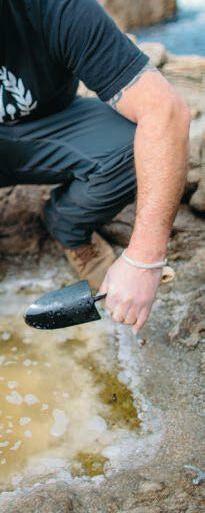

“Down here, nature really runs everything,” Overhulser reflected as we packed up our haul. “I’m just the steward of it.”

SEASONING
Months after foraging, we reconvene at Il Grillo in Carmel where executive chef Quinn ompson is preparing some salt-centric dishes to showcase several different blends. Overhulser has had strong working relationships with local chefs since the beginning of his venture. ompson, formerly the sous chef at Sierra Mar at Post Ranch Inn, was the first chef to try the cliff salt after Overhulser left a sample in his mailbox.
“e alignment with chefs is key,” Overhulser explains. “I love to see the whole story and know how my product is being used. It’s important to me to know the chef, know our philosophies match and be open to their wants and needs.”
“Carlo is definitely a collaborator,” adds ompson in the Il Grillo kitchen. “He’s like minded and he’s doing us a service that we would love to be doing ourselves if we had the time.” ompson, whose family came to Big Sur in the mid-1800s to mine gold (the Plasketts of the eponymous Plaskett Creek), grew up with stories of foraging in the woods and waters of Big Sur and is drawn to the adventurous spirit of Big Sur Salts. “I feel strongly about showcasing the salt for what it is, and not just have it drown in my food.”



www.ediblemontereybay.com 29
Overhulser foraging in Big Sur




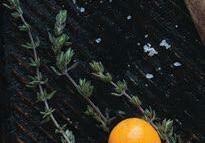


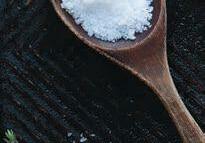

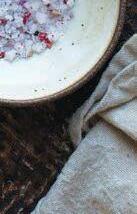
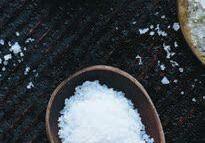

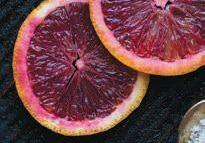















30 edible MONTEREY BAYSPRING 2018
Although chefs mostly purchase Overhulser’s plain salt or the Pico Blanco finishing salt, today ompson is playing with a series of blends: Old Coast Canyon; Tassafari (a colorful blend with red, green and yellow bell peppers, black peppercorn, garlic, lemon and lime); fruit forward Santa Lucia Highlands blend (Scheid Vineyards’ Triple Layer Red with raspberries, blackberries and coriander); and Elote, a smoky/spicy blend featuring chipotle peppers, lime zest, cilantro and garlic.
ompson starts with a crudité plate of crisp and pungent vegetables (fennel, watermelon and Easter egg radishes, Tokyo turnips, mustard leaves and fennel flowers) to see how the intense aromatics of the dish play with the flavors of the Tassafari salt blend. e salt absorbs a generous pour of olive oil, creating a rich, herbaceous paste that complements, but does not overpower.
A beautifully marbled bistro-cut steak is cooked in an unapologetically simple manner—seared with butter and herbs and served sliced on a cutting board with the various salt blends for a choose-yourown adventure. Of course, I try all the combinations and the result is four completely different steaks, the flavor profiles of each blend making distinctly bold statements.
Thompson ends the tasting with chickpea-battered Romanesco, typical of the small plates he likes to feature at Il Grillo. Both the batter and finished product are seasoned with the Old Coast Canyon— the sage, leek and thyme adding subtle herbal notes to the dish. Although the vegetable is fried, the result is very delicate—tender Romanesco in a pillowy batter with a slight crunch—and I’m impressed by how well the flavors of a very aromatic blend are tempered by the other ingredients.
“If I’m going to introduce this business to a larger clientele, chefs are going to be the way to do that,” Overhulser insists.



Monterey Bay Aquarium executive chef Matthew Beaudin was the first to buy in bulk immediately after Overhulser established his company and has harvested with him on several occasions. He loves how those experiences deepen the connection with the food he’s serving, “ere’s a story behind our salt!” Beaudin exclaimed. “at’s so incredible! Out on those cliffs, the guy is literally risking his life for salt! We’re not just purchasing the product—we’re purchasing a partnership. Big Sur Salts is part of our family, and so is his story.”

For Overhulser, sharing his story is sharing his love for the wild beauty of Big Sur. On the day we harvested I noticed that he marked many of his pools with a heart-shaped rock. “The first place I found salt the pool was heart shaped, so I started marking them all that way,” he says with a shrug. “Big Sur gave love to me, so I try and give it back.”
Rosie Parker, a native New Englander, likes to complain of missing home while living the Santa Cruz high life—surfing, hiking, writing and working for a delicious craft brewery.

RECIPE: Go to www.ediblemontereybay.com/recipes for Quinn ompson of Il Grillo’s recipe for Crispy Garbanzo Battered Romanesco using Big Sur Salt’s Old Coast Canyon blend.
Opposite, Il Grillo chef Quinn ompson and the Crispy Garbanzo Battered Romanesco and steak he prepares with salts from Big Sur Salts
www.ediblemontereybay.com 31
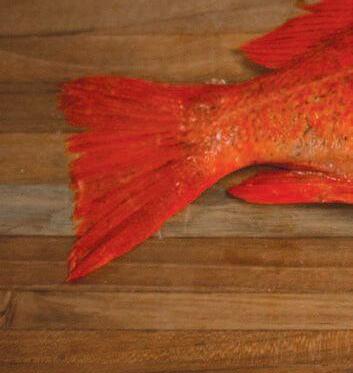

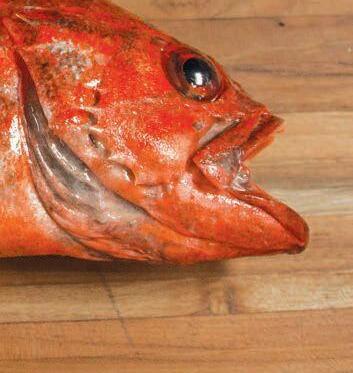



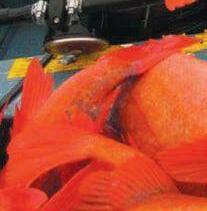













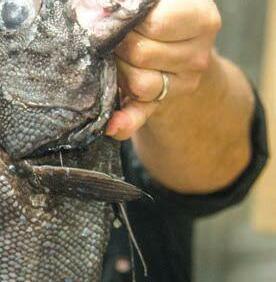


32 edible MONTEREY BAYSPRING 2018
“ese are some of the best fish on the planet, but almost nobody has heard of them, suppliers don’t carry it; it’s all getting exported!”
Clockwise from upper left, fisherman David Seefeldt bringing in vermilion rockfish, chef Jeremy Tummel with a grenadier and a vermilion rockfish in the chef’s kitchen
ON THE HOOK
TRASH TALK
STORY AND
PHOTOGRAPHY BY JOHN COX
Perhaps you’ve heard the term “trash fish” before and assumed, as its derogatory name suggests, that it refers to unappetizing or even inedible fish. Or maybe you’ve heard it in a more positive context, like a celebrity chef dinner. While there is no definitive list of species, I have come to think that the best answer to the question, “What is trash fish?” is the most literal. Trash fish is the portion of a fisherman’s catch that has little or no commercial value and is treated as disposable. Fishermen either throw the fish back into the ocean, enjoy them for dinner themselves or pass them around the commercial sphere, where they frequently go rotten in shops or restaurant coolers because guests refuse to order items they are unfamiliar with.
But as seafood sustainability becomes an increasing concern, and consumers seek out not just economical but ethical products, so-called “trash fish” are quickly becoming recognized as a delicious and valuable alternative to more popular species. For example, the company Trashfish based in Los Angeles is touting its bimonthly seafood boxes on its website as “the freshest and most exclusive seafood in Los Angeles.” Clearly, one man’s trash is another’s treasure, and this isn’t the first time a fish once discarded on the dock became a story worth telling!
A BRIEF HISTORY OF THE PATAGONIAN TOOTHFISH
Lee Lantz, an ambitious young fish purveyor from California, traveled to Valparaiso, Chile in the 1970s, searching for a new fish to bring to the American market. Species that had been market staples, like halibut, were getting more expensive and boats were making longer trips and fishing deeper waters. Lantz, like many other fish buyers, was forced to travel around the globe. A few years earlier, he had begun importing a fish called congrio from Chile, and this time, the fish that caught his attention was a gruesome-looking black sea monster with bulbous eyes and a prominent lower jaw lined with jagged teeth. e species was considered too oily to eat, but when Lantz came across the same mysterious fish at a second market, he took a piece back to his apartment to try. e result was anticlimactic. e meat was flavorless with an oily consistency, yet Lantz knew this was perfect for the American market! e American palate enjoyed fish that had a neutral flavor, something that could hold up to being battered and fried into fish sticks and eaten with pungent sauces.
Lantz knew that Bacalao de profundidad, or “cod of the deep,” the fish’s colloquial name, wasn’t one that would appeal to his buyers; nor would its formal name, Patagonian toothfish. After some deliberation, he settled on Chilean sea bass—which associated the fish with a famil-
iar flaky white meat and had just enough of an exotic flair for modern marketing. Over the following decade, interest in Chilean sea bass soared from an initial export price of 45 cents per pound paid to the fishermen to five-star treatment by iconic restaurants such as the Four Seasons in New York City. As demand continued to grow and the public grew aware of this fashionable fish, Chile permitted larger international trawlers to target wider fishing zones and increase their annual catch. As we are now aware, the Patagonian toothfish takes upwards of 17 years to reproduce, so by the early 1990s, when the catch was up to 34,000 tons, the entire adolescent population had been decimated. By the time conservation efforts caught up, the species was on the brink of collapse and since then, the recovery process has been long and arduous. Today, the Patagonian toothfish is still listed on the Seafood Watch Avoid List, joining the likes of slimeheads (orange roughy), whore’s eggs (uni) and other marine species that ultimately became victims of overly successful marketing.
LOCAL TRASH, INTERNATIONAL SALES
A family-operated fishing fleet in Monterey can routinely catch more than 33,000 pounds of local groundfish (such as lingcod, rock cod and petrale sole) in a single trip. Where does it go? Ask Sheila Bowman, a veteran of the Monterey Bay Aquarium in charge of culinary strategy for the Seafood Watch program, and she will tell you, “ese are some of the best fish on the planet, but almost nobody has heard of them, suppliers don’t carry it; it’s all getting exported!” And groundfish aren’t the only export from Monterey. Squid, spot prawns, black cod and other delicacies are whisked away in unmarked trucks to far-flung destinations. With such demand, is it any surprise that the prospect of a single cash transaction on the dock appeals more to a hardworking and small-scale fishing operation than schlepping across Monterey to chefs who might buy a couple of fish while complaining about price and consistency? is is why I have such respect for fishermen who, after a fishing marathon, make the effort to sell their fish locally.
Jerry Wetle—who over the last 31 years has worked tirelessly to build up a small fleet of fishing boats from the Channel Islands to Moss Landing—is considered by many Monterey chefs to be THE resource for local fish. When I send Wetle a text to get his thoughts on the topic of trash fish, his response is characteristically short and to the point. “I think everybody would agree that grenadier is one of the most underutilized fish and is extremely cheap. It’s ugly, although the flavor is amazing.” Also known as “rattail” fish, this deep sea dweller has a monstrously large head and a long slender body tapering into a tail.
www.ediblemontereybay.com 33
Why so-called trash fish are actually a secret treasure—and why it matters
However, grenadier is only the common name for a whole family of fish, with dozens of species found across the world’s oceans.
Alan Lovewell, founder and CEO of Real Good Fish, a Moss Landing-based, community-supported fishery program that connects fishermen and consumers in the same way that CSAs connect farmers and their customers, has been providing locally sourced Pacific grenadier (and Pacific rockfish) to Bay2Tray, a program that works with the USDA Farm to School program to place local fish on school menus. Not only do students have the opportunity to eat local fish in their lunches, but as Lovewell explains, they are also “making a full-circle connection for children to learn that seafood is much more than fish sticks, that fish come from our backyard bay, and as benefactors, we must also be stewards of the resource.” By bringing local fishermen in to talk with them, the children learn about the commercial fishing industry and what it means to fish sustainably.
Wanting more information on grenadier, I visited Santa Barbara’s weekly Saturday Fishermen’s Market (at present, Monterey has no such independent market where consumers can buy directly from fishermen, although a new effort to boost both the supply and demand for fish landed from Monterey Bay with a “Fish Hub” could change that. (See “Fishing for a Comeback” online or in EMB’s Winter 2017 issue.) It’s just after 6am, but there is already a line of curious buyers huddled over large tubs of freshly caught fish. e market is filled with local groundfish of every shape and size, along with several species of crabs and buckets of whelks. I pause for a moment to speak with fisherman Garrett Rose about the cooler of fish he is displaying. Inside, there is a mix of sole, black cod and longspine thornyhead. I ask Rose if he ever catches grenadier and his girlfriend Jessica laughs and exclaims, “I think you are the first person to ever ask about grenadier!” Rose goes on to say, “I actually caught two on this trip, but I took them home and ate them. ey are delicious, but nobody wants to buy them.”
e story of grenadier rings hauntingly familiar to that of Patagonian toothfish. At the moment Macrouridae, or the grenadier fish family, holds a “Best Choice” rating by the Monterey Bay Aquarium’s Seafood Watch program and chefs and fishermen regard it as undervalued. But how long will it take to find its own spotlight, and when it does, will we have the resources in place to manage the fishery? Will some out-of-town marketing firm rebrand Pacific grenadier as Big Sur Rock Bass? Will it go the way of the rest of Monterey’s fresh seafood and become lost to international markets?
ETHICAL TREASURE HUNTING

David Seefeldt was born and raised on the Big Sur coast, where he has created a way of life and earns his livelihood from the rugged mountains and coastline that are his home. It’s not easy to get by living off the natural resources in Big Sur, but Seefeldt is a multi-talented forager who hunts chanterelles in the winter, fishes during the summer and carves jade in between. Seefeldt usually sells his entire catch either to a single buyer in San Francisco or to Monterey County restaurants. When I ask about market demand and whether he is able to get a fair price for the fish, he responds, “Vermilion rockfish and lingcod are not nearly as renowned as salmon or halibut and are generally way undervalued. ey are not well known because they are not readily available due to the quotas and availability of the rockfish. Most vermilion rock-
fish on the market come from Canada, which has a huge rockfish industry. In my opinion, it is not sustainable—their large quotas and the type of gear that they use is usually drag nets.”
Unlike this large-scale method, Seefeldt’s fishing trips start with a drive to Monterey to load up with 1,200 pounds of ice. e next morning, he wakes up at 4am and launches a 14-foot aluminum skiff directly off the beach into the ocean. His goal is to have his hooks in the water by sunrise, and he’ll fish with hook and line at about a 1,000feet depth for about 12 hours, targeting primarily vermilion rockfish and lingcod. Temperamental weather, as well as low hook and line quotas, limits his fishing. But Seefeldt tells me his most challenging obstacle is “educating my buyers on how fresh my catch is. I normally sell my fish the next day after being caught, which means restaurants are able to put it on their menu one day after it was caught.
“My goal is to stay self-sustained and live off sustainable natural resources that we have on this remote rugged coastline,” Seefeldt says. “is has always been my home and hopefully the next generation can call it home also.”
And there it is, the single point that makes all of this so important: ere is no such thing as trash fish, only undervalued and overvalued fish, and our valuations will make a material difference to future generations. At the time of writing this article, I noticed Chilean sea bass being sold at a local market for $44 per pound; grenadier was selling for just $5 per pound.
With the seafood industry in a constant state of evolution, it is critical for consumers to educate themselves through programs and resources like Seafood Watch. You can’t assume that the guidelines or best practices of yesterday still apply today. Twenty years ago a self-respecting chef wouldn’t touch a frozen fish, but today onboard flashfreezing technology has revolutionized the industry, helping to both preserve freshness and kill parasites as soon as fish has been caught. Ten years ago, people recoiled at the idea of farmed tilapia, but after years of international pressure to improve aquaculture practices, today it is considered a sustainable seafood choice.
Just a couple of years ago putting Chilean sea bass on a restaurant menu would have been almost as egregious as serving dolphin steaks, but today there are several certified Chilean sea bass fisheries helping the population recover and trying to ensure a responsible return to restaurant menus. Bowman has many wonderful thoughts and observations on the issue of trash fish, and local seafood in general, but one of her most poignant comments is, “Let go of old stories and embrace new stories.” e story of trash fish is old; it is time to embrace seafood sustainability seriously on a global level, or there will be no story left.
e former executive chef at Post Ranch Inn’s Sierra Mar, John Cox is now pursuing a number of projects, including serving as a chef-partner at Cultura—comida y bebida in Carmel and e Bear and Star at the Fess Parker Wine Country Inn in Los Olivos. For more, go to www.cheohncox.com or follow him on Instagram and Facebook.
RECIPES: See p. 39 for Local Vermilion Rockfish in Pink Peppercorn-Salt Crust and www.ediblemontereybay.com/recipes for Ginger Brined Grenadier with Parsnip Purée, Bacon Beurre Blanc and Apricot Sweet and Sour Glaze.
34 edible MONTEREY BAYSPRING 2018












I find grenadier to be similar to black cod with a good fat content and neutral flavor. Season, top with some butter or olive oil, then cook it directly under the broiler (skin side down) until top of filet is darkly caramelized and meat begins to flake.
is is such a beautiful fish, I always feel obligated to leave it whole! Try cooking the fish in a salt crust (see recipe).

ese dense filets hold up well to pan roasting. Put a sauté pan on high heat with a spoonful of rice or canola oil. Heavily season the filet with salt and pepper then gently place it skin side down in the pan, gently shaking so it doesn’t stick. Add some butter to the pan and baste the top of the filet with butter until it is finished.
ere is nothing like fresh sardines cooked on an open grill! Grill them whole and pull the bones out once they are cooked.
Try stacking the mackerel filets with dried kelp or kombu. Let them marinate against the seaweed overnight and then either slice and eat raw or quickly cook.
is fish is very lean and delicate. I like to use more subtle flavors when working with lingcod and gravitate toward cooking the filet in a parchment “papillote” to gently steam the fish and keep it from drying out.

You can never go wrong with classic French technique. Try dredging the sole filet in some seasoned flour and then cook it in a pan with brown butter.
I like to put the shark filet in a mixture of 6 cups milk, 2 cups kosher salt and 1 cup sugar and let it brine overnight. is helps smooth out the flavor and make the fish more neutral.



ese fish are tiny but worth the effort. You can remove the bones with tweezers and then stuff them and serve each of your guests their own bite-sized fish!

36 edible MONTEREY BAYSPRING 2018
Other Names and Sub Categories Seafood Watch Pro Tips from Chef John Cox
Grenadier Rattail Good Alternative
Vermilion Rockfish Vermilion, Pacific Red Snapper Good Alternative
Bocaccio Merou, Jack Good Alternative
Sardine Best Choice
Mackerel Unrated
Lingcod Buffalo Cod
Best Choice/ Good Alternative
Sole Petrale Sole, Sanddabs
Petrale Sole: Best Choice/Good Alternative Sanddabs: Best Choice
Shark Spiny Dogfish, resher
Dogfish: Best Choice resher: Good Alternative
Longspine ornyhead
Best Choice










www.ediblemontereybay.com 37





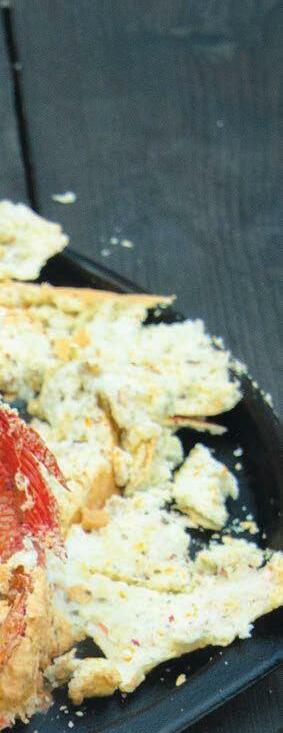



38 edible MONTEREY BAYSPRING 2018
LOCAL VERMILION ROCKFISH IN PINK PEPPERCORN-SALT CRUST
Courtesy John Cox, chef-partner, Cultura–comida y bebida in Carmel and e Bear and Star in Los Olivos Serves 2 to 3






1 1½- to 2-pound whole rock cod 5 egg whites
3 cups kosher salt 7 tablespoons ground pink pepper

Zest of 1 orange (zest with microplane)
Zest of 1 lemon (zest with microplane)
Prepare the fish by gutting, scaling and remove the gills. (Your fishmonger or fisherman may be willing to do this for you.) Rinse and thoroughly dry the fish.
Whip the egg whites with whisk attachment in a standing mixer bowl or by hand until they are glossy and hold soft peaks when you remove the whisk. Fold the remaining ingredients into the whipped egg whites.
Place the fish, belly side down as though it were swimming, on a large baking sheet. Use a butter knife or offset spatula to spread the egg white mixture evenly over the fish.
Roast the egg white-coated fish in a 375° F oven for approximately 30 to 40 minutes. Test the fish for doneness by inserting a paring knife through the crust and into the thickest part of the filet. If the tip of the paring knife comes out warm to the touch, the fish is done. Allow to rest for 5 to10 minutes before cracking the crust open in front of your guests.
www.ediblemontereybay.com 39
EDIBLE ICONS
M.F.K. FISHER AND ME
How bad dorm food led to an unlikely nine-year culinary correspondence with a legendary food writer






 BY ANINA MARCUS PHOTOGRAPHY BY MICHELLE MAGDALENA AND PAUL FUSCO
BY ANINA MARCUS PHOTOGRAPHY BY MICHELLE MAGDALENA AND PAUL FUSCO
e caretaker answered the door and led my best friend and me into a large semi-darkened bedroom where M.F.K. Fisher was resting, one light blanket covering her frail form.

“How was your trip?” she asked, her whisper amplified by a voice box—a result of the debilitating effects of Parkinson’s disease.
“So glad to finally meet you after such a long correspondence,” she continued.




My friend and I sat in stillness as we tried to make out her words. She was fiercely attentive to our presence, even though she stared straight ahead and did not move.
It was 1989 and we were in the Sonoma County village of Glen Ellen (or as Fisher liked to call it, e Valley of the Moon, the name given to it by indigenous tribes who settled there long ago) at her “last house,” built on a 535-acre ranch.
Now 80 years old, Mary Frances Kennedy Fisher—this high priestess of the pleasures of the table, this doyenne of great food writing and this woman I had been corresponding with for nine years—had invited me and a friend to lunch.
40 edible MONTEREY BAYSPRING 2018
“Please help yourself to what’s in the fridge. ere is some very good cheese, bread, and you must try the peaches picked just today. My caregiver left early, so you gals are on your own,” she whispered.

I walked into the living room. e yellow-painted walls were lined with floor-to-ceiling bookshelves, and no door separated it from the entrance to her kitchen, as if books and food were always meant to be close at hand. Wide windows above the kitchen sink let my gaze wander outside to the large wooden rocking chairs on the porch and to sagebrush, oaks, lupine, poppies and orange trees spreading out in every direction.
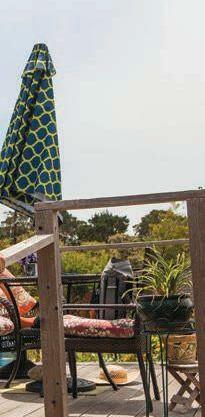
When I first started writing to Fisher, I had just returned from a nine-month sojourn in Paris. I went there after high school to study cooking, French and mime in no particular order, promising that when I returned, I would start my college education.



en as a freshman at UC Santa Barbara I liked dance, writing, nutrition and cooking. I couldn’t decide on a major, but I knew one thing for sure: I wanted to write to my favorite food writer and express my disgust for dorm food. Also, maybe subconsciously, I needed someone to help shape my interests towards this big looming thing called “e Career.”
e cafeteria served tomatoes with no tomato flavor, meat that was stringy and overcooked anything. I lived mostly on peanut butter and crackers, baked potatoes and iceberg lettuce. For some this would be fine, but for me just back from Paris—well frankly I’ll admit it, I was in shock.
I had no hopes of Fisher writing me back, but I was sure she would understand my misery.

Her voice and writings had stayed with me ever since I stumbled upon her book, How To Cook a Wolf, among my mom’s cookbooks. It was published in 1942 and at first glance I assumed it was some oldfashioned butchery book, until I opened it and read the chapter headings: How to Rise Up Like New Bread; How to Make a Pigeon Cry; How to Be Cheerful rough Starving; and my absolute favorite, How to Boil Water.


For instance, here she is describing how much she detests the soup vichyssoise: “A bland unctuous broth with frigid smoothness. It is too bad this piece of gastronomical voodoo is so expensive to make and then 1/16 of a teaspoonful of ground mace to be added at just the right moment?”
She says about starches used to thicken soups:”You can pretend when using pastes like tapioca that you are back in a second-rate Swiss Pen-
www.ediblemontereybay.com 41
Photo of M.F.K. Fisher by Paul Fusco; others by Michelle Magdalena
sion watching three Englishwomen of advanced spinsterhood measure out their digestive tonic and trying not to listen to the Austrian honeymooners one table behind you. Even noxstalgia is a doubtful pleasure when evoked by limp globules of starch in the bouillon.”
Her writing was so clear, so fresh and so unapologetic of her strong opinions. She was the first food writer I read who would call things as she saw them. She was saying: Let’s wake up the palate, folks. And more importantly, she made me understand that when one writes about food, one is also writing about comfort, companionship and communion— in short, the fundamentals of living.
Fisher was 68 when she received my first letter in 1976. She had already written more than 25 books, including what are considered her best known works—Serve It Forth, Consider the Oyster, How To Cook a Wolf and An Alphabet for Gourmets—all written between 1936 and 1949. She had been the Time-Life series editor for e Cooking of Provincial France, had traveled and lived in France, Switzerland and Italy, and was now single after having survived three marriages.
I got my first letter back in five months. It was typed on Eaton’s Corrasable Bond, 25% cotton fiber paper, and she always signed off in ballpoint pen.
She wrote: “I am very glad that you are interested in what you rightly call the art of cooking and I would like to help you write your own cookbook sometime.”
In another paragraph she advised: “Good food largely depends on the quality of the food being used.”
One year later, she addressed my complaints about institutional food: “It is impossible to cook 500 portions of anything and have them be more than palatable. Now and then I send a copy of Mrs. Rombauer’s Joy of Cooking to convicts or undergraduates and all of them report that after eating the food they are offered they find real enjoyment in lying on their cots and reading the recipes for an imaginary meal.”
What a concept. If you cannot eat good food, know how to dream about it!


In later letters, I mentioned that I had started dancing and had to watch calories and had started working in a Mexican restaurant, while taking a break from college for a semester.
“It is good that you are deciding on some sort of work to help with your expenses,” she wrote. “Of course it is wise to watch calories, but I don’t see why you need to shun providing them for other people. Most professional chefs I have known have been very thin.”
She was always pushing me to think about the future and a good direction to take. In her 1983 letter she wrote: “What about your readings on nutrition? It is such a valuable science. Do you know about all the work that is going on quietly to develop new sources of protein in the world? is of course will involve ocean bottom farming and so on.”
When I was deciding about choosing a dance major, she wrote to me: “Why can you not become an ‘interpreter of music’ especially with your appreciation of music? It sounds like something you should concentrate on.”
We had begun to plan to meet, but she had to keep calling it off due to illness or a travel assignment or because many times she was busy hosting guests. I was also out of commission when I got a diagnosis of mononucleosis that took me away from college for a year or so.
In 1984, I was still finding it difficult to get back to school after my illness and she was finding her work going much slower.
She wrote: “It is always difficult to return to what is called normal living, after even a short vacation. A week in hospital, especially after sedation, can throw some people into real panic about accepting the responsibilities of ‘outside’ life again. I hope you are not finding all this readjustment too painful. Please write to me about it if you care to.
“Here, I continue to work hard. Although I am slower than I used to be…and much less interested in taking on any new commitments. ere will be another collection of old and new stories out later this spring from Knopf. It is called Sister Age and I think you will like some of it.”
e last letter I received was in 1984. She never mentioned how much harder life was getting from Parkinson’s, but she did say she was not traveling anymore and wrote: “is morning I watched the partial eclipse of the sun and found it strangely mysterious and moving, as I often

42 edible MONTEREY BAYSPRING 2018
have in the past. I am told that this is the last one in this century, so I don’t seem to need to worry anymore about putting a pinhole in one piece of cardboard and focusing it on another piece!! One less thing to do!!!!”
In Fisher’s home, my friend and I munched on some terrific cheese and Fisher insisted that we try the wine that someone left her. She told us to check out the lovely taqueria down the road if we had time and mentioned she still thought corn tortillas were the only tortillas one should eat.
At one point she looked straight at me with those piercing blue eyes and said: “I dare say we have all too many gastronomic journals already, but I do think you could write some kind of cookbook for the elderly, since it is ghastly what they have to eat in those places they call nursing homes.”
I told her I had started my course work towards a physical therapy degree and loved working with the elderly population. I noticed many of them were alone and living on frozen food. I will have to change that, I thought.

When we were close to leaving, she said: “By the way, on your way out, be sure to look at my bathroom. You will love the red kimono I have hanging on the wall and the sunken bathtub.”



ree years later Fisher passed away in her home on the great ranch. She was 83. I have been working as a physical therapist for the past 15 years, mostly making home visits to the elderly. I think of myself as someone who helps them “wake up their joints and muscles” in the same way that Fisher called on us all to “wake up our palates.” On almost every visit, I ask, “Did you eat today? Do you have enough food in the house?” I also start questioning their bread preferences, as I have fallen hopelessly in love with making sourdough.
e long slow buildup of yeasts by letting flour and water ferment over time fascinates me. I love using grains like spelt, emmer, einkorn and amaranth, and tasting ancient wheat again! I know Fisher would be happy to know I found a way to break bread together with others, share stories and give comfort in these uncertain times, as she says in her inimitable style in e Gastronomical Me:
“It seems to me that our three basic needs, for food and security and love, are so mixed and mingled and entwined that we cannot straightly think of one without the others. So it happens that when I write of hunger, I am really writing about love and the hunger for it, and warmth and the love of it and the hunger for it. And then the warmth and richness and fine reality of hunger satisfied…and it is all one.”
Anina Marcus is just now starting to understand how to make good bread after five years of scraping dried flour out from under her fingernails. She currently has 30 subscribers to her “bread-of-the-month club” and has a waiting list for those interested in joining as soon as there is an opening. “Gluten/shmuten,” she says, “just eat real good bread.” She lives in the Carmel Highlands and can be reached at aninamar12@gmail.com.
www.ediblemontereybay.com 43
... she made me understand that when one writes about food, one is also writing about comfort, companionship and communion—in short, the fundamentals of living.
ON THE FARM KNOW YOUR FARMER
As organic food becomes more widely available, CSAs struggle to survive




 BY KATHRYN MCKENZIE
BY KATHRYN MCKENZIE
It’s hard to believe that I had never eaten a rutabaga until recently. In fact, I had never eaten beets, turnips or parsnips—ungainly root vegetables that are transformed into sweet, savory goodness when roasted with a little olive oil and salt and pepper. I had no idea what I was missing, until I joined a CSA.
CSAs—short for Community Supported Agriculture—are particularly good at coaxing their customers into trying produce that they never would have attempted otherwise. You could say that CSAs have turned several generations on to the wonders of chard, fennel and other worthy vegetables that were not in their mothers’ repertoires.
But beyond that, “it gives a customer direct access to the place where food comes from,” says Tom Broz, founder of Live Earth Farm in Watsonville, which has offered a CSA for the past 23 years. “e community of customers and our relationship with members is at the heart of it.”
e CSA concept, developed in the early 1980s in Massachusetts, was originally devised to strengthen that all-important bond between farmer and consumer. It is a simple idea: Customers pay in advance

for a share of the harvest, giving the farmer capital to work with—sort of like a loan. e payback: a box or basket of vibrantly fresh produce each week or each month.

CSAs also foster a deeper connection, an opportunity for customers to actually see where their fruits and vegetables are grown, and to get to know the land and the farmer in an intimate way. In Japan, a similar system has been called “food with a farmer’s face.”

But as the organic movement has grown and become more mainstream, it’s getting harder to find and keep CSA members. Competition from retail groceries that now sell more organic products, like megastores Walmart and Costco, and meal kit services like Blue Apron, have drawn down the customer base.
Attracting and retaining customers was the hot topic at a CSA workshop held in late January as part of the EcoFarm Conference at Asilomar Conference Center in Pacific Grove. Farmers talked about everything from using Instagram and Facebook for promotion to how to make it easier for food stamp recipients to become CSA members.
44 edible MONTEREY BAYSPRING 2018
Photos at Live Earth Farm this page courtesy of the farm; opposite, photo at Monkeyflower Ranch by Julie Cahill
Broz says the challenges and uncertainties of CSAs are something fairly new for farmers. “It used to be kind of a stable market for us,” he says, noting that 80% of Live Earth’s revenues used to come from its CSA, but due to membership declines and the farm’s consequent diversification of its income, only 40% of the farm’s revenues now come from its CSA.
“It’s a rapidly changing market,” admits Julie Morris of Morris Grassfed Beef in San Juan Bautista, which recently notified its customers of changes the ranch needed to make to its CSA. “Producers need to adjust or they won’t survive.”











Morris and other local CSA farmers have noticed that their membership numbers grew steadily through the early 2000s but plateaued, or even declined, in the past few years. Part of the problem for Morris Grassfed is making its prices competitive, even though processing meat locally with artisanal butchers means spending more for this type of quality.
at’s why Morris and her husband Joe are making some modifications, which they’ve outlined in an open letter to customers on the Morris Grassfed website: only processing pre-sold beef, for instance, and a less-frequent delivery schedule. In addition, all orders for 2018 had to be placed by Feb. 28—a big change from the previous rolling order dates.
Some farmers have reduced their CSA schedule, such as Route 1 Farms in Santa Cruz, which put its winter CSA on hold. Other farmers are doing away with their CSAs altogether, such as Monterey County-based Serendipity Farms and Fogline Farm in Santa Cruz.

Serendipity owner Jamie Collins decided to make some changes when she saw that her CSA membership was declining, and putting together CSA boxes was requiring a full day that took away from being in the fields. “It’s such a tough business anyway that I figured I might as well just do the parts that I like,” she says.
Her solution: establishing a “virtual farm stand” page on Facebook, where she posts whatever excess produce is available, takes payments via PayPal and offers pickups at her farm or a farmers’ market. She says her sales this way have matched what she was previously making from the CSA; she also sells at farmers’ markets and directly to restaurants.
Caleb Barron of Fogline Farm says he was forced to move when the landlord declined to renew his lease, and he couldn’t find a new property where he could raise both vegetables and chickens. “Chickens have always been the main aspect of the farm and the most profitable, so I chose to find land that worked for chickens and not veggies,” he says. Fogline’s focus is now on serving customers through local farmers’ markets.
Small farmers who offer CSAs are at a disadvantage these days, says Live Earth’s Broz. “It’s not easy, and it’s pretty labor intensive,” he says. “Labor is a real issue.” Another challenge is that “it is not an economy of scale—you can’t scale it up because you’ll lose that personal connection to the customer.”
Yet another concern is that people are no longer content with what one farm can offer and are demanding more choices. One CSA responding to that challenge is Farmhouse Foods/Eat with the Seasons, the one I order from. President/CEO Becky Herbert began bringing in items from other small farms around San Benito County as a way to keep the family CSA going when her father became ill and had to stop farming for a few years. Now, its 1,200-plus members can select produce from more than 20 farms, as well as organic cheeses, meats, breads, herbs and more, through an online ordering system that streamlines the process.

Live Earth has also been a leader in offering customizable CSA shares, giving its members the opportunity to opt for a pre-selected box or go online each week to make choices from seasonal fruit and vegetable options and add-on pantry items from other local producers like



www.ediblemontereybay.com 45










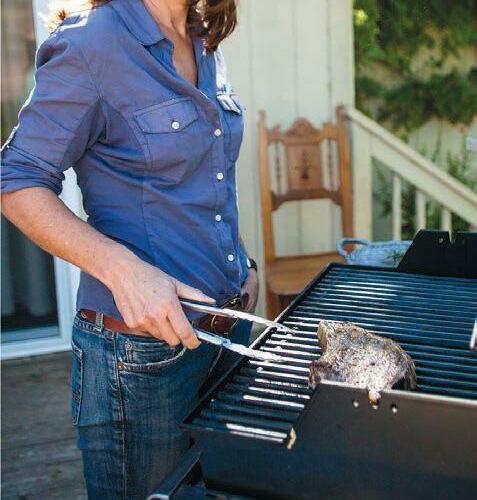

46 edible MONTEREY BAYSPRING 2018
Photos this page, top from left, by Ted Holladay and Julie Cahill; bottom by Margaux Gibbons. Photos opposite, top by Margaux Gibbons; bottom by Larry Gerbrandt
bread from Companion Bakeshop, pastured eggs from Sol Seeker Farm and pasta made with locally grown wheat from Pie Ranch; both Eat with the Seasons and Live Earth use Farmigo as their online ordering platform.
Farmigo rolled out new software in December to make customization easier—a far cry from the CSA model of yore, but one that’s increasingly sought. “e CSAs we see growing are the ones that have morphed their model over time to be more convenient for the consumer,” says Farmigo CEO/founder Benzi Ronen, who adds that farms offering choices are more likely to thrive, as well as those providing a home delivery option. (Locally, J&P Organics takes CSA boxes to its customers’ doors in Monterey and Santa Cruz counties; see listing on p. 48.)
Farms are also finding ways to offset slumping CSA membership. For instance, Live Earth Farm has developed a wholesale program over the past five years through which it sells directly to local restaurants, independent grocery stores like New Leaf and Staff of Life, and the online marketplace Good Eggs in San Francisco. It has also added another farmers’ market in Mountain View to those it attends.

Selling to the competition is an additional option—Live Earth sold produce to Blue Apron in 2016 and 2017, and has dabbled with large distributors such as Coke Farm.


Alternative distribution systems that require less commitment than the typical CSA have also sprung up to connect eaters with those who produce their food, like the “meat club” run by Jack Kimmich of California Kurobuta, which offers pastured heritage pork, and the periodic seafood deliveries made by Ian Cole and Charlie Lambert of Ocean2Table, who let customers know by email each time a catch comes in.
No matter the model, one of the most valuable services provided by CSAs—and one of their best retention tools—remains the bond they can foster between producers and their customers. Live Earth Farm hosts regular events to educate the public about organic farming and the importance of knowing where your food comes from, as does Garden Variety Cheese, the dairy and meat CSA operated by Rebecca King. And that’s something that you can’t get from a supermarket or a meal kit: “It’s not a business. It’s much more than that,” says Broz.
“I think farmers need a cheerleader so they do not lose the faith in this being an outlet,” says Herbert. “I firmly believe every farm can offer a unique CSA membership based on what sets them apart from other growers.”
“Farmers are tough, dynamic and creative,” says Collins. “If anyone can figure it out, they can.”



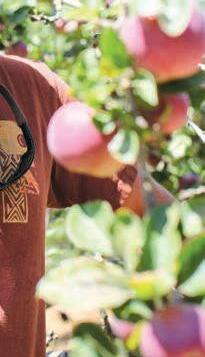

Kathryn McKenzie, who grew up in Santa Cruz and now lives on a Christmas tree farm in north Monterey County, writes about sustainable living, home design and health for numerous publications and websites.

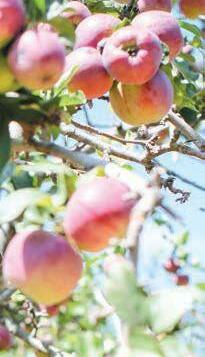
Some of our past and present CSA operators: p. 46, Tom Broz and Julie Morris; this page, Becky Herbert and Caleb Barron

www.ediblemontereybay.com 47
MONTEREY BAY AREA CSAS

Did you know you there are local CSAs that will provide duck eggs, bread, goat yogurt and coffee for your breakfast? Sustainable seafood and pastured pork, beef and lamb as well as prepared foods for your lunch and dinner? And herbal bitters for your liquor and medicine cabinets?
Each of our local CSAs is different and the variety of products they offer continues to expand. To find one that’s uniquely right for you, read the detailed descriptions that follow.
Blossom’s Biodynamic Farm • Corralitos 831.246.1137 | www.blossomsfarm.com Infused body oils, herbal bitters, tonics, teas, tinctures, salves, cough syrups, superfoods. Local home delivery. $475/year or $125/quarter.
Bounty of the Valley • Greenfield 831.594.1065 | bountyofthevalley@yahoo.com
Organic produce. Free local delivery and pickup sites in Monterey County. $25/week in south county, $30/week in Salinas/Monterey Peninsula.



Evergreen Acres Dairy • Tres Pinos 831.628.3736 | www.evergreenacresdairy.com
Organic raw goat milk, goat cheese, goatgirt, kefir, duck eggs, soups, other seasonal items. Pickup at sites in the San Francisco Bay Area, Santa Cruz County, and at the Monterey Bay Aquarium. $50/share.
Farmhouse Foods/Eat with the Seasons • Hollister 831.245.8125 | www.eatwiththeseasons.com
Organic produce, eggs, breads, preserves, grassfed and pastureraised meats, and prepared foods such as salads, dips and soups. Pickup sites in the San Francisco Bay Area, south Santa Clara County, San Benito County and north Monterey County. $20$53/week plus add-ons for eggs, meats, cheeses, breads, prepared foods and other items.
Garden Variety Cheese • Royal Oaks 831.761.3630 | www.gardenvarietycheese.com
Yogurt, feta and cheese made from all-natural sheep milk; pasture-raised, free-range lamb and pork. Pickup at San Francisco Bay Area and Santa Cruz farmers’ markets, Happy Girl Kitchen in Pacific Grove and at the farm. $500/six-month, adopt-a-ewe program.
48 edible MONTEREY BAYSPRING 2018
Photo by Margaux Gibbons
H&H Fresh Fish Co. • Santa Cruz 831.462.FISH | www.hhfreshfish.com Sustainably caught local seafood. Pickup sites in Santa Cruz County and the South San Francisco Bay Area. One meal per week is $10 single, $18 couple, $30 family; two meals per week are $18/$30/$60.
High Ground Organics • Watsonville 831.254.4918 | www.highgroundorganics.com
Organic fruits, vegetables and flowers. Pickup sites in the San Francisco Bay Area, and Santa Cruz and Monterey counties. $25/week plus $10 flower share.
Homeless Garden Project • Santa Cruz 818.554.7919 | www.homelessgardenproject.org
Organic fruits, vegetables, herbs and flowers. Pickup at the farm. $650 for 23 weekly pickups at farm, $475 for u-pick. Additional $115 for 4-week extension through November.
J&P Organics • Salinas 831.578.9479 | www.jporganics.com
Organic fruits, vegetables, flowers and eggs. Home delivery to Monterey and Santa Cruz counties. $25/week for fruits and vegetables, $30 for box plus eggs, $31 for box plus flowers, $35 for box, flowers and eggs.
Live Earth Farm • Watsonville 831.763.2448 | www.liveearthfarm.net


Organic fruits, vegetables, bread, pastries, eggs, pantry staples. Pickup sites in the San Francisco Bay Area, and Santa Cruz and Monterey counties. $25/week with variety of add-ons.
Lonely Mountain Farm • Watsonville 650.504.5976 | www.lonelymountainfarm.com
Organic produce, flowers, goat milk soap. Pickup in Aptos, San Francisco and Los Gatos. $25/week for produce, $12 for flowers. Goat milk soap $50/season.
Mariquita Farm • Watsonville 831.706.6799 | www.mariquita.com
Organic vegetables. Pickup in San Francisco, East Bay and South San Francisco Bay areas. $15 minimum order per week, $30/week “mystery box.”
MEarth • Carmel 831.624.1032 | www.mearthcarmel.org
Organic vegetables, fruits, herbs. Pickup at Hilton Bialek Habitat. $300/12-week season.
Morris Grassfed Beef • San Juan Bautista 831.623.2933 | www.morrisgrassfed.com Grassfed, artisanally butchered beef. Free delivery for half-split. $9.29/pound for half-split, $9.89/pound for aged half-split. $150 minimum order.
Real Good Fish • Moss Landing 831.332.1234 | www.realgoodfish.com
Sustainably caught seafood. Pickup sites in the San Francisco Bay Area, South San Francisco Bay, Hollister, and Santa Cruz, Santa Clara and Monterey counties, $14-$88/week, depending on size of share.
Route 1 Farms • Santa Cruz 831.426.1075 | www.route1farms.com Organic produce and flowers; add-ons of coffee and other pantry staples available. Pickup sites in Santa Cruz and Santa Clara counties. $476 individual, $756 family/28-week season.
UCSC Farm • Santa Cruz 831.459.3240 | https://casfs.ucsc.edu
Organic vegetables, fruits, herbs. Pickup at UCSC Farm and Westside Farm & Feed. $560/22-week season.
www.ediblemontereybay.com 49
THE PRESERVATIONIST



MAKING GOAT CHEESE



When I was a new mother, I hung clothes out on a line in the full sun to dry. e quiet would sometimes be broken by a shrill cry and I would run inside, thinking I had heard my young baby crying as he awoke from his nap. I would bolt at top speed and then halt as I neared the room, slowly peeking in to see my baby sleeping happily in peaceful silence. e noise I had heard was the neighbor’s goats in the distance. eir call was indiscernible from the noise my baby made when he wanted to alert me that he was done with his nap. We bought raw goat milk by the quart from these neighbors who had a tiny herd of goats. It was wonderful when they would go out of town and ask us to milk their goats, because in exchange we could keep all of the milk. We happily agreed, but the goats produced way too much milk for us to drink.
BY JORDAN CHAMPAGNE PHOTOGRAPHY BY PATRICK TREGENZA

Around this same time I met a woman named Lynn Selness at an apple cider pressing party at our home in Aromas. We harvested apples from a local abandoned orchard and invited friends over for a weekend of pressing cider. Lynn came with apples, 10 gallon-sized glass bottles and a lot of energy. She immediately got down to business and I was impressed. I soon learned she had her own herd of goats and sold goat milk and cheese; she taught me how to make goat cheese that day as we pressed fresh apple cider. Lynn was a busy woman raising a bunch of children in addition to the goats, and I found her recipe to be simple and delicious, just the way



50 edible MONTEREY BAYSPRING 2018
Transforming milk to chèvre with the help of some inspiring local goat herders
I like
“He was the first person I ever met who actually spoke goat. As we walked with the goats, he called when they drifted too far and they would bleat back to him, as if in conversation.”
is page, Charlie Cascio with his goats; opposite, Jordan Champagne making chevre




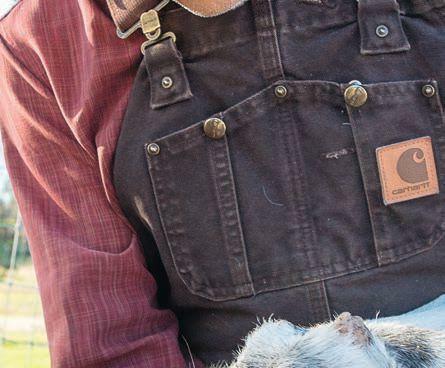

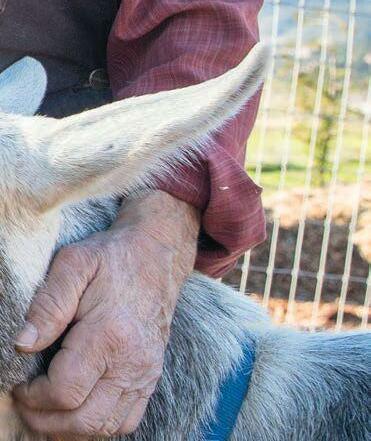

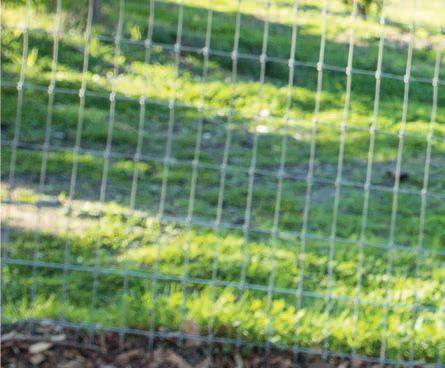



www.ediblemontereybay.com 51
it. Her recipe started my journey of making my own chèvre every time our neighbors went out of town.
Years later, I met a man named Charlie Cascio. We had heard legends about him and had visited the famous redwood tree in Big Sur named “Charlie’s Tree,” where he was said to have lived in a large natural cavity for two years. When we first met Charlie, he was living at his Sweetwater Farm in Palo Colorado Canyon, where he tended olive and fruit orchards, raised vegetables and kept bees as well as goats.
Charlie was herding his goats along the dirt road when we drove up, and we hopped out to take a walk with him. He was the first person I ever met who actually spoke goat. As we walked with the goats, he called when they drifted too far and they would bleat back to him, as if in conversation. It was remarkable. We received a tour of his milking shed and homestead, and Charlie taught me his style of making goat cheese. Charlie, who was the head chef at the Esalen Institute from 1998 through 2004, is a perfectionist in the kitchen, and he also makes a variety of aged hard cheeses. I was impressed by his passion for quality although his technique was a little more complicated and precise than I was used to.
Charlie’s homestead in the canyon burned in the Soberanes Fire in 2016. He and his goats took shelter in his cheese cave as the fire tore through; his goats were taken in temporarily by another goat herder while he considered the future. At this point Charlie was at a crossroads as he was faced with either rebuilding or relocating. Chef Tim Wood at Carmel Valley Ranch was a long-time friend and buyer of Charlie’s hard cheeses, featuring them on his menu. He wanted to offer any help he could to Charlie, so he suggested the goats take up residence right on the ranch where guests could enjoy seeing directly where the cheese comes from. It was a wonderful solution and the goats are happily adjusting to life on the ranch!
e main difference between Lynn’s and Charlie’s cheese is that Charlie adds a flavorboosting enzyme called Flora Danica and is more exact with his temperatures and times. e end results are completely comparable, and I think it has to do with a matter of personality and preference. I love them both!
CHÈVRE
Courtesy Jordan Champagne, chef and proprietor, Happy Girl Kitchen Co. in Pacific Grove
Chèvre is a rich creamy cheese that you can only make with goat milk. It is a wonderful place to start for the home cheesemaker, as there is very little that can go wrong! You will need to source the vegetable rennet and mesophilic culture. I source mine from a website called New England Cheesemaking, and it is often available at Mountain Feed & Farm Supply in Ben Lomond. Both cultures are very inexpensive for a year’s supply. e rennet helps separate the curds from the whey, and if you find your cheese is too firm, then add a little less. If your cheese is not separating enough, then perhaps your rennet has expired. e mesophilic culture thrives at a “medium” temperature, close to room temperature, and is very easy to work with. e process takes two days, but most of that is tender loving neglect. e warm temperature of the milk fresh from the goat is perfect for making this chèvre.
1 gallon goat milk* 7 drops vegetable rennet
1/8 teaspoon powdered mesophilic culture 1/8 teaspoon powdered Flora Danica culture ¼ cup pure water (nonchlorinated), room temperature

Warm the milk to 86° F in a nonreactive pot. Add 7 drops of vegetable rennet and 1/8 teaspoon powdered mesophilic culture to ¼ cup room temperature water (nonchlorinated). Mix well and add to milk. After about 30 minutes you will begin to see the milk separating into curds and whey. Once it starts, you know the chemistry is taking root and you do not need to tend to it any longer. Let it sit out on your counter at room temperature for 8–12 hours. Next, pour off the whey through cheesecloth to strain out the curds. For my cheesecloth I use a fabric called “flour sacks,” which can be purchased at any hardware store and used over and over again. At this point you can save the whey for whatever you desire; on most farms it is fed back to the goats—they love it!
Hang the cheesecloth with a bowl underneath to catch the remaining drips of whey. If there is no obvious spot, you can get creative with a high beam or hook or anywhere you can leave it dripping for 18 hours. I usually lay a wooden spoon across a tall pot and tie the cheesecloth to the spoon, and the whey drips into the pot. Let it strain and culture for 18–24 hours or longer if you want it to become a little sharper. Take curds out of the cheesecloth and shape with your hands. Knead in ½ teaspoon of sea salt. Wrap in wax paper and put in an airtight container in fridge. Chèvre will keep for 1 week.
Before serving, you can add flavorings to your cheese, like chopped fresh herbs or cracked pepper; chili flakes add a nice smoky undertone. en get ready for your cheese to become the hit of the next potluck!
*Editor’s Note: Lynn Selness’ Summer Meadows Farm makes weekly deliveries of raw goat milk to Happy Girl Kitchen; other goat farms in our area that could be contacted for fresh, local milk include Pasture Chick Ranch in Hollister, Evergreen Acres in Tres Pinos and Harley Farms in Pescadero, to name a few. And Champagne says that goat milk she has bought at Trader Joe’s works just fine for her cheesemaking.
52 edible MONTEREY BAY SPRING 2018
Jordan Champagne is the co-owner and founder of Happy Girl Kitchen Co. She has a passion for preserving the local, organic harvest and loves sharing her secrets at workshops she teaches in Pacific Grove and Oakland.
APTOS



Persephone
7945 Soquel Drive • 831.612.6511 www.persephonerestaurant.com

With a namesake like the mythic Persephone, this restaurant in Aptos proclaims its deep reverence for seasonal cooking. emes central to harvest, winter and spring are core to Persephone’s story, and are reflected in the changing menu at this fine dining destination, where chef Cori Goudge-Ayer presents inventive, ingredient-driven creations. e restaurant is a family-run passion project, bringing together parents, siblings and a long history of culinary arts in a beautifully redesigned space overlooking Aptos Creek. Open W–Su 4:30–9pm.
BIG SUR
Sierra Mar at Post Ranch Inn

47900 Highway 1 • 831.667.2800
www.postranchinn.com


Executive chef Elizabeth Murray and executive pastry chef Ben Spungin use exceptional ingredients, many grown on site, to deliver a unique gastronomic take on the Big Sur experience. Dinner features a 4-course prix fixe menu, and lunch offers 3-course and 5-course options. Choose from almost 3,000 different wines from the Wine Spectator Grand Award-winning wine list. Arrive before sunset for breathtaking views from this iconic restaurant’s floor-to-ceiling windows and cliffside terrace. Open daily for lunch 12:15–2:30pm, dinner 5:30–9pm. Advanced reservations required.
Dine Local GUIDE

CAPITOLA
East End Gastropub

1501 41st Avenue • 831.475.8010 www.eastendgastropub.com
East End Gastropub is the newer baby sister to the popular West End Tap & Kitchen, but aside from sharing owners and chefs, East End’s beautiful, recently renovated modern interior is entirely different from West End and offers its own robust, sophisticated, beerfriendly menu. Chef Geoffrey Hargrave has created dishes that are familiar yet innovative, such as the bacon braised pork shank with red heirloom polenta. Share plates, pizzas and salads come in generous portions for a family-style meal. e restaurant also offers its own brews, along with local rotating taps and a strong wine list. Open Su– 11:30am–9:30pm, F and Sa 11:30–10pm. Weekend brunch 10:30–2:30pm. Happy hour M–F 4–6pm.
e Penny Ice Creamery
820 41st Avenue • 831.204.2523
www.thepennyicecreamery.com

Open Su– noon–9pm, F–Sa noon–10pm
See e Penny description under Santa Cruz for more.
Shadowbrook
1750 Wharf Road • 831.475.1511

www.shadowbrook-capitola.com
A Santa Cruz County landmark since 1947, the worldfamous Shadowbrook continues to be an overwhelming favorite with locals and visitors alike. Its fine food, extensive wine list and unparalleled setting and ambiance have earned it numerous awards, including Northern California’s “Most Romantic Restaurant” and “Best Date Night Restaurant.” Gift cards and reserva-

www.ediblemontereybay.com 53
Photo by Patrice Ward
more about WHALE CITY BAKERY in Davenport, see
56.
All of these restaurants emphasize local ingredients, and they also advertise in Edible Monterey Bay! Stop by for a free issue, and tell them that we sent you!
For
p.
tions available online. Open M–F 5–8:45pm, Sa 4:30–9:45pm, Su 4:30–8:45pm.
CARMEL
Andre’s Bouchée


Mission Street between Ocean and Seventh avenues 831.626.7880 • www.andresbouchee.com
Chef Benoit Petel utilizes the bounty of the Monterey Bay with the best seasonal ingredients in the classic and creative French cuisine he prepares at this warm and elegant restaurant in downtown Carmel. Standouts include cream of mushroom soup with truffle oil; escargot with garlic parsley butter; steak frites and seasonal fish dishes. Petel works with the Monterey County farmers’ markets and other local sources to obtain the freshest ingredients. Open for lunch F–Su noon–2pm and nightly for dinner 5:30–9:30pm. Wine hour menu served at the bar daily 5:30–7pm.
Aubergine
Monte Verde Street at Seventh Avenue • 831.624.8578 www.auberginecarmel.com
Located within the romantic L’Auberge Carmel, a visit to Aubergine feels like a trip to Europe. Executive chef Justin Cogley was named one of Food & Wine’s best new chefs of 2013. He has been nominated multiple times for a James Beard award and it’s no wonder—he’s an eloquent and imaginative interpreter of fine seasonal ingredients. Executive pastry chef Yulanda Santos delights with stunning and inventive desserts. Open daily 6–9:30pm.

Basil Seasonal Dining

San Carlos street between Ocean and Seventh avenues (Paseo Courtyard) 831.626.8226 www.basilcarmel.com

“Organic, local and seasonal” are not just buzzwords at Basil. is cozy restaurant in the Paseo Courtyard was awarded three stars from the national Green Restaurant Association. New chef Andrea Palmieri of Rome’s BucaVino has been introducing more of an Italian influence. Owner Denis Boaro continues to provide a full bar and great selection of California wines. Many vegan and vegetarian entrées available. Heated, dog-friendly outdoor seating. Open daily for lunch and dinner from 11:30am, Sa and Su brunch 11am–2pm.
Covey Breakfast Restaurant



8000 Valley Greens Drive 831.620.8910 • www.quaillodge.com
Overlooking a pond and manicured grounds, the newly remodeled Covey Breakfast Restaurant includes motorcycles from the Moto Talbott Museum in Carmel Valley in a nod to Quail’s annual motorsports event, while chef Brian Kearns captures the essence of a homecooked Carmel Valley meal. e weekday à la carte menu includes nourishing skillets, eggs benedict and huevos rancheros; on weekends, enjoy an enhanced American breakfast buffet. Both indoor and outdoor seating come with beautiful views. Open daily 6:30–11am.
Edgar’s at Quail

8000 Valley Greens Drive 831.620.8910 • www.quaillodge.com
Taste the fresh ingredients harvested from local organic farms that are hand selected by Edgar’s executive chef Brian Kearns and exquisitely prepared by his culinary team into the savory dishes available on its new menus.
54 edible MONTEREY BAY SPRING 2018
Set in the clubhouse of Quail Lodge & Golf Club, Edgar’s restaurant and bar features a casual elegance with its indoor and outdoor fireside dining located alongside the natural backdrop of the golf course and Santa Lucia Mountains. Edgar’s at Quail is proudly guided in the principles of sustainability by the Monterey Bay Aquarium Seafood Watch and focuses on local farm-to-table options. Open daily 11am–9pm.
Il Grillo


Mission Street between Fourth and Fifth avenues 831.238.9608 • www.ilgrillocarmel.com

A more casual yet equally outstanding sister to Carmel’s La Balena, Il Grillo is staking out its own creative culinary personality with the addition of chef Quinn ompson. Homemade desserts are made by Emily Garcia. Both ompson and Garcia come from the Monterey Bay area and share local food knowledge and traditions through their cooking. Dinner menus are driven by local and sustainably raised ingredients, with beautiful and delicious results. Garden seating available. Open M–Sa 4–9pm.
La Balena

Junipero Street between Fifth and Sixth avenues 831.250.6295 • www.labalenacarmel.com
Winner of EMB’s 2014 Local Heroes award for Best Chef/Best Restaurant, La Balena has a seasonal menu that changes daily but always expresses an inventive take on the rustic food of a Tuscan trattoria. e outstanding culinary team sources ingredients from local organic farms and prepares the restaurant’s pastas and slowcooked meats from scratch daily. Owners Anna and Emanuele Bartolini have created an excellent Italian wine list and a warm, inviting atmosphere, complete with back garden seating. Open Tu–Su 5–10pm; check website for lunch hours.
Waypoint Bar & Deck 8205 Valley Greens Drive 831.620.8910 • www.quaillodge.com

Locals and visitors alike have an exciting and beautiful new spot to stop for a whiskey flight, local craft beer, creative cocktails, wines by the glass or bottle, and contemporary small bites and appetizers made with local, sustainable ingredients. e new Waypoint Bar & Deck offers monthly chef specials like “Bubbles & Birdies” (fried chicken and Champagne) and a tantalizing regular menu featuring such items as chef Brian Kearns’ beef Shortrib Nachos with Charred Avocado, Roasted Heirloom Carrots, burgers, flatbreads and duck fat fries. Also available for private events, rental fees apply. Open W–Su 5–10pm.
CARMEL VALLEY

Lucia Restaurant & Bar
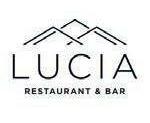
Bernardus Lodge & Spa • 415 W. Carmel Valley Road 831.658.3400 • www.bernarduslodge.com/wine-cuisine
Indulge in artisanal California country cuisine, awardwinning wines and an expansive heated outdoor terrace with the finest view from any restaurant in Carmel Valley. Named for the Santa Lucia mountain range and wine appellation that beckons to the south, renowned chef Cal Stamenov serves both his signature tasting menu and dishes à la carte. Wine list is equally notable. A private chef’s table and wine cellar also are available. Enjoy live music Monday, Tuesday, Friday and Saturday evenings aw well as Saturday and Sunday for brunch. Open daily 7:00am–10:00pm.

www.ediblemontereybay.com 55
Trailside Café and Beer Garden
3 Del Fino Place • 831.298.7453


www.trailsidecafecv.com

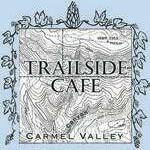
ose needing to refuel after a day on the trail can head to Trailside Café for home-cooked meals in Carmel Valley. Beer lovers get to choose from 16 on tap, and sports fans can watch games on the HDTVs. Locals are treated to specials on Mondays and Tuesdays. On the weekends enjoy live music in the beer garden. Check out the calendar on its website for more details. Dog friendly in outdoor areas. Open daily 8am–9pm
DAVENPORT
Whale
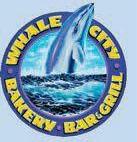
City Bakery
490 Highway 1 • 831.423.9009 www.whalecitybakery.com
Davenport’s artistic charm and oceanside location make it hard not to slow when you pass through on Highway 1. ose in the know always stop at the historic Whale City Bakery. e bakery tempts with housemade breads, pastries, muffins and pies—and that’s only the beginning! Whale City also offers a full restaurant that serves up comfort classics and other hearty dishes. e bar and live music every ursday attract a loyal local following. Open daily 6:30am–8pm.
FELTON
e Cremer House

6256 Highway 9 • 831.335.3976 www.cremerhouse.com

Housed in the oldest building in Felton, e Cremer House showcases progressive, made-from-scratch food and drinks with a nod to its historic mountain surroundings. is alehouse has filled a niche in the San Lorenzo Valley, bringing to this restored and revered property craft beer, cider and wine on tap, and combining it with organic and sustainable fare made with local ingredients. Open Tu–, Su 11:30am–9pm, F–Sa 11:30am–9:30pm.
MONTEREY
e Club Room 2 Portola Plaza 831.649.2698 www.portolahotel.com/dining/the-club-room
e Club Room offers a fresh, seasonal, buffet featuring made-to-order omelets, assorted housemade pastries and muffins, sliced cold cuts, fine artisan cheeses, bottomless mimosas and much more. Dine in the cozy fireside dining room, or breathe in the fresh coastal air on the outdoor, pet-friendly, heated patio. Open for breakfast daily 6–11am.
e C restaurant + bar
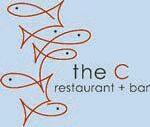
InterContinental e Clement Monterey 750 Cannery Row • 831.375.4500 www.ictheclementmonterey.com
Step into e C restaurant + bar, and the bustle of Cannery Row will seem like a world away. Elegant yet relaxed, e C offers stunning ocean views from its floor-to-ceiling windows and oceanside deck. Executive chef Matt Bolton provides equally gorgeous food, imaginatively prepared from sustainably sourced seafood, meats and produce. Creative cocktails include international specialties, as well as sparkling wine flights from around the world. Open daily 6:30am–10pm, Happy Hour 4–7pm Su–. Live Music F–Su noon–3pm, –Sa 6–9pm.
56 edible MONTEREY BAY SPRING 2018
Jacks Monterey


2 Portola Plaza

831.649.7830 • www.jacksatportola.com
Jacks Monterey offers “California Cultural Cuisine” and seats guests beneath the trees in a glass-topped atrium where they can enjoy the sun by day and the stars at night. Reflecting the palette of the Monterey Peninsula, the new space is decorated with ocean blues, driftwood browns and the greens of coastal flora. Chef Danny Abbruzzese’s new seasonal menu provides a melting pot of flavor profiles from the entire California coastline and other exotic locales. Open for lunch daily 11:30am–4pm; dinner daily 4–11pm.
Peter B’s Brewpub
2 Portola Plaza 831.649.2699 • www.peterbsbrewpub.com


Experience Monterey’s original craft brewery, Peter B’s Brewpub, located behind the Portola Hotel & Spa. Enjoy great food and award-winning handcrafted beers. Watch your favorite game on one of 18 HDTVs or enjoy the pet-friendly heated patio with fire pits. Peter B’s is open daily with nightly Happy Hour from 4–6:30pm. Open Su 11am–11pm, M– 4–11pm, F 4pm–12am, Sa 11am–12am.
e Poke Lab 475 Alvarado Street info@thepokelab.com • www.thepokelab.com

Serving fresh, light and sophisticated casual dining made from local, gluten free and sustainable ingredients, e Poke Lab has revamped the Monterey lunch scene. ree signature bowls include two with a variety of fresh tuna and salmon and one vegetarian option. Build the rest of your sizable creations with a choice of rice or salad and varied toppings and sauces. Sushi burritos are also available; order online for quickest pick-up. An official Seafood Watch partner restaurant, e Poke Lab only serves seafood rated sustainable. Open M–Sa 11am–8pm. Follow Instagram (@ePokeLab) for weekly food truck locations. Inquire about catering.
Schooners Coastal Kitchen & Bar

Monterey Plaza Hotel & Spa 400 Cannery Row • 831.372.2628 www.schoonersmonterey.com Sit out on the newly remodeled oceanside patio if you can, but it’s still considered seaside dining if you are seated inside the dining room, whose polished wood, bay windows and seafaring décor seem like the interior of a sailing ship. Schooners Coastal Kitchen & Bar serves sustainable seafood and prime steaks. e restaurant takes a creative Californian approach to soups, fresh salads, sandwiches and wood-fired flatbreads, paired with a diverse wine list featuring local favorites. Open daily 6:30am–11pm.
TusCA Ristorante
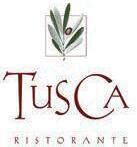
Hyatt Regency Monterey Hotel & Spa 1 Old Golf Course Road • 831.657.6675 www.hyattregencymonterey.com
Blending the beauty and bounty of Tuscany and California, and inspired by the hearty appetite and abundance of southern Italy, TusCA serves up seasonally sourced menus made from fresh, local produce, meats and fish. TusCA chef Steve Johnson delights diners with meals both intriguing and indulgent, particularly those baked in his wood-burning oven or served with the housemade pastas. Open daily for breakfast and lunch 6:30am–1:30pm, dinner 6–9pm Tu–Sa.

www.ediblemontereybay.com 57
PACIFIC GROVE
Happy Girl Kitchen Co.

173 Central Avenue • 831.373.4475 www.happygirlkitchen.com


e menu changes daily at Happy Girl’s airy and bright Pacific Grove café, but the food is always delicious, organic and reasonably priced. e sandwich of the day is $6.50, and a bowl of the soup of the day is $6. To drink, you’ll find kombucha on tap and freshly roasted Verve coffee brewed to perfection. Homemade baked goods include a daily scone, cookies and turnovers. Check the website for information on seasonal workshops. Open daily 7:30am–3pm, coffee and tea served until 5pm.
Jeninni Kitchen + Wine Bar

542 Lighthouse Avenue • 831.920.2662 www.jeninni.com
Inspired by flavors of the Mediterranean, Jeninni Kitchen + Wine Bar’s rich and decadent cuisine takes you on a journey from Morocco and Spain to the Levant, birthplace of owner and sommelier, amin Saleh. Don’t miss chef Matthew Zimny’s charred octopus, lamb burger with signature eggplant fries and occasional paella nights and other special events. Open every day except Wednesday, 5pm until close. Happy Hour— ”sips and snacks”—4–6pm.
Passionfish

701 Lighthouse Avenue • 831.655.3311 www.passionfish.net
If you’re looking for a restaurant with playful, spectacular food and a scrupulous commitment to sustainability, this green-certified restaurant is hard to rival. e elegant dining room is celebratory yet relaxed, and the award-winning wine list features many sustainable names and is priced at retail. Chef Ted Walter’s menu is ever changing with the seasons, but always includes delicious organic local produce, inventive slow-cooked meats and an array of sustainable seafood choices. Open daily 5pm.
Point Pinos Grill

79 Asilomar Boulevard • 831.648.5774 www.ptpinosgrill.com


With sweeping views of the coast and a relaxed clubhouse vibe, this scenic spot has blossomed under the direction of executive chef Dory Ford. For breakfast, choose from huevos rancheros, chicken fried steak and an array of tasty omelets. For lunch through dinner, enjoy dishes like Ale-Steamed Mussels and Crispy Fried Dry Rubbed Jerk Chicken Wings paired with craft beers, local wines or a house specialty cocktail. Open M–F 7:30am–7pm, Sa 7am–7pm, Su 7am–6pm. Happy Hour is M–F 4–6pm.
PEBBLE BEACH

e Bench
e Lodge at Pebble Beach, 1700 17-Mile Drive 866.543.9318 • www.pebblebeach.com/dining
Overlooking the 18th hole at Pebble Beach Golf Links, e Bench at e Lodge at Pebble Beach delivers an eclectic menu inspired by international styles and methods, which uses the innovative technique of wood roasting and open-flame cooking. You can also enjoy one-of-a-kind craft cocktails, as well as an array of draft beers and wines by the glass. Open daily 11am–10pm.
58 edible MONTEREY BAY SPRING 2018
Gallery Cafe


e Lodge at Pebble Beach, 1700 17-Mile Drive 866.543.9318 • www.pebblebeach.com/dining
Overlooking the first tee of Pebble Beach Golf Links, Gallery Cafe offers a wide selection of breakfast choices, from light smoothies to omelets and pancakes. For a casual lunch, try the excellent burgers or choose from a delicious selection of artisan sandwiches, plus the best milkshakes this side of the 1950s. Open daily 6am–2pm.
Pèppoli at Pebble Beach

e Inn at Spanish Bay, 2700 17-Mile Drive 866.543.9318 • www.pebblebeach.com/dining
At Pèppoli, the scents of Italian herbs and spices fill the air, and the décor transports you to a cozy Tuscan villa. e menu is big and bold, ripe with traditional pastas, seafood and meats. e extraordinary wine list is matched by equally impressive dishes, including delicious desserts, all with stunning views of Spanish Bay. Open daily 5:30–10pm.
Roy’s at Pebble Beach

e Inn at Spanish Bay, 2700 17-Mile Drive 866.543.9318 • www.pebblebeach.com/dining
It’s all about big flavors and the gorgeous ocean view at Roy’s at Pebble Beach. Fresh seafood is front and center, where sushi, sashimi and blackened rare Ahi tuna are prepared to perfection, but many exciting meat dishes and island salads are also featured on the extensive Hawaiian-fusion menu. Add a dynamic wine list, exceptional desserts and an energetic environment, and you have one impressive dining experience, all overlooking Spanish Bay. Open daily for breakfast 6:30–11am, lunch 11:30am–5pm, dinner 5:30–10pm.
Stave Wine Cellar at Spanish Bay

e Inn at Spanish Bay, 2700 17-Mile Drive 866.543.9318 • www.pebblebeach.com/dining
A combined wine lounge and retail shop, Stave Wine Cellar is a luxurious yet casual space that is ideal for special wine dinners or gathering with friends and colleagues. You can pair varietals by the glass with a menu of cheese and charcuterie plates. In addition to nearly 30 wines and eight craft beers by the glass, Stave has more than 200 wines for purchase by the bottle, including a wide selection of coveted bottles. A knowledgeable staff, including certified sommeliers are on-hand. Open Tu–Sa 2–10pm, Su–M 2–7pm.
STICKS


e Inn at Spanish Bay, 2700 17-Mile Drive 866.543.9318 • www.pebblebeach.com/dining

Open for breakfast, lunch and dinner, Sticks is the perfect place for seasonally diverse California cuisine in a lively sports bar atmosphere. Savor a tasty meal, a cold draft beer, specialty cocktail or one of the many appetizers, while enjoying sports on flat-screen TVs. Outside on the patio, enjoy seating next to a fire pit while soaking up gorgeous views of e Links at Spanish Bay and the Pacific Ocean along with nightly bagpiper music. Ask about specials and new menu additions. Open daily 6am–9pm.
Stillwater Bar & Grill


e Lodge at Pebble Beach, 1700 17-Mile Drive 866.543.9318 • www.pebblebeach.com/dining
Stillwater Bar & Grill prides itself in offering the freshest and most flavorful in sustainable seafood and organic produce. Whether it’s breakfast, lunch or dinner—or Stillwater’s famous Sunday Brunch—the menus are sure to delight. Shellfish lovers will marvel at the bountiful seafood tank, while those who prefer turf to surf can
www.ediblemontereybay.com 59
choose from a variety of meaty options. Each of these delectable feasts is enhanced by fantastic views of Carmel Bay and the 18th hole of Pebble Beach Golf Links. Open daily 7am–10pm.
e

Tap Room

e Lodge at Pebble Beach, 1700 17-Mile Drive 866.543.9318 • www.pebblebeach.com/dining
e Tap Room is more than a legendary 19th hole with an outstanding selection of draft and bottled beers, vintage wines and top quality spirits. It’s also a world-class steakhouse serving up hearty all-American fare, from burgers to prime rib to filet mignon. Renowned for its extensive collection of prized golf memorabilia, e Tap Room is a comfortable and inviting place for watching televised sporting events or recounting your successes on the courses of Pebble Beach. Open daily 11–12am.
SAN JUAN BAUTISTA
Vertigo Coffee Roasters

81 Fourth Street • 831.623.9533 www.vertigocoffee.com
Artisanal coffee roasted on site as well as local craft beers, wood-fired pizzas, salads, sandwiches, breakfast items plus pan dulce from El Nopal bakery in Hollister have made Vertigo a locals’ favorite as well as a great find for visitors en route to the San Juan Mission, Pinnacles or other area attractions. Open M–Sa 7am–6pm, Su 8am–6pm.
SANTA CRUZ
515 Kitchen & Cocktails 515 Cedar Street • 831.425.5051 www.515santacruz.com

ere’s nothing quite like rooftop dining—the expanse, the view, the feeling of being high above. In Santa Cruz, there’s no better place than multi-level 515 Kitchen & Cocktails to sip on an astounding cocktail with a witty name and nosh on inventive small plates while gazing down at Cedar Street, especially following the Wednesday farmers’ market, when there is unmatched hustle and bustle. You’ll even find some of that produce on your plate, seasonally crafted by chef Paul Queen, as well as in your glass, courtesy of bar manager Ethan Samuels. But if the outdoor vantage point feels too ex-
posed, any of the cozy nooks or barstools upstairs, or calming tablescapes downstairs are sure to suit your mood. Open M–Tu 5pm–12am, W–F 5pm–1:30am, Sa 3pm–1:30am, Su 3pm–12am.
an epicurious lifestyle
104 Bronson Street, Suite 13 831.588.7772 • www.anepicuriouslifestyle.com

An event-based commercial kitchen and dining space in a carefully curated warehouse in the historic Seabright Cannery building, an epicurious lifestyle is available for unique private events and hosts a monthly, seasonal family-style dinner for 20 that is open to the public. Other public events also have a limited number of tickets; check the website for future dates.
Assembly

1108 Pacific Avenue • 831.824.6100 www.assembly.restaurant


is full-service restaurant offers rustic California cuisine based on local, seasonal and sustainably sourced ingredients. Under the direction of chef Jessica Yarr and beverage director Zane Griffin, satisfying food pairs with an intriguing selection of craft beers, wines and cocktails. Natural light in daytime and the soft glow of copper accents at night bathe community tables and comfortable nooks accommodating parties of all sizes. Open for lunch weekdays 11:30am, dinner W–Su until late, brunch 10am Sa–Su, closed M–Tu.
Charlie Hong Kong
1141 Soquel Avenue • 831.426.5664 www.charliehongkong.com



Charlie Hong Kong has been providing the Santa Cruz community with healthy, sustainable, affordable and high-quality food since 1998. e colorful, casual eatery’s delicious fusion of Southeast Asian influences and the Central Coast’s local organic produce has made it an inclusive, family-friendly, neighborhood favorite. Its slogan is “love your body, eat organic,” and its cuisine is proof that fast food can be good for you. All signature dishes are vegan with the option to add meat or fish. Gluten-free modifications available. Open daily 11am–11pm.

60 edible MONTEREY BAY SPRING 2018
e Crow’s Nest
2218 E. Cliff Drive • 831.476.4560
www.crowsnest-santacruz.com



A perfect spot to enjoy lunch or catch a sunset over the harbor, the nautical-themed Crow’s Nest is a Santa Cruz institution that never goes out of style. ere’s always something happening, from free seasonal ursday night beach parties to comedy nights and happy hours. Famous for its salad bar and house-smoked salmon, e Crow’s Nest is a member of Seafood Watch and is a certified green business. Open daily for breakfast 7:30am–11:30am; lunch M–F 11:30am–2:30pm and Sa–Su 11:30am–3pm; dinner M–F 5pm, Sa–Su 4:30pm.
Food Lounge

1001 Center Street info@scfoodlounge.com www.scfoodlounge.com
A modern venue for food, art, entertainment and community, Food Lounge hosts events like the oncemonthly Night Market (second Friday), monthly Jazz Jams and Open Mic (every ursday). It’s also a dynamic community space available for private events such as parties, fundraisers and business mixers. At all events, the Food Lounge bar features local beer, wine, cider and small-batch craft spirits. And local goods to take home are available from the Food Lounge PantryLocal Artisan Marketplace. For a full list of events and hours, see website calendar.
Laílí
101B Cooper Street • 831.423.4545 www.lailirestaurant.com

Exotic flavors of the Silk Road are served in a stylish dining room decorated in eggplant and pistachio colors and on a hidden candlelit patio. Locals rave about Laílí’s homemade naan served warm from the oven with a selection of Mediterranean dips. ere is a wide variety of deliciously spiced vegetable dishes, organic whenever possible, and all meats are hormone free and free range. Open Tu–Su for lunch 11:30am–2:30pm, dinner 5–close.
La Posta
538 Seabright Avenue • 831.457.2782
www.lapostarestaurant.com




A cozy neighborhood bistro not far from the Santa Cruz yacht harbor, La Posta chef Katherine Stern prepares Northern Italian cuisine using local ingredients—some foraged and some grown on nearby organic farms. Charcuterie is house cured; pasta, bread, and gelati are made in-house, while the balance of the menu reflects whatever produce is freshest right now. A sister restaurant of Soif Restaurant and Wine Bar, La Posta also offers a great selection of wines. Open Tu– 5–9pm, F–Sa 5–9:30pm, Su 5–8:30pm, M closed.
Pearl of the Ocean

736 Water Street • 831.457.2350

m.mainstreethub.com/Pearloftheocean
Award-winning chef/owner Ayoma Wilen goes beyond the expected traditional spice-infused dishes of Sri Lanka, creating locally inspired daily specials using fresh, organic produce from farmers’ market produce and sustainably harvested seafood. Customer favorites include butternut squash curry, crab curry and wild salmon curry. To round out the flavor experience, there is a dizzying array of sides, like coconut leek sambal and kale mallam. e warm colors, altars and blessings that decorate the space help guests get a sense of Sri Lanka’s world-class hospitality, culture and beauty. Open for lunch daily 11am–2:30pm; dinner Su– 5–9pm and F–Sa 5–9:30pm.
e Penny Ice Creamery

913 Cedar Street • 831.204.2523
www.thepennyicecreamery.com
Lines out the front door of its converted Spanish bungalow are evidence of Penny’s popularity. All ice cream, including bases, is made from scratch on the premises using local organic ingredients when possible. Dozens of exotic flavors rotate seasonally, but two favorites are chocolate caramel sea salt and strawberry pink peppercorn. Open daily noon–11pm.
See also e Penny under Capitola.
61
www.ediblemontereybay.com

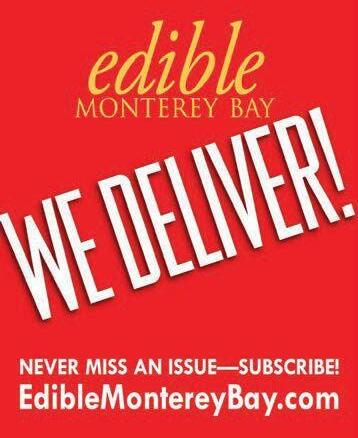
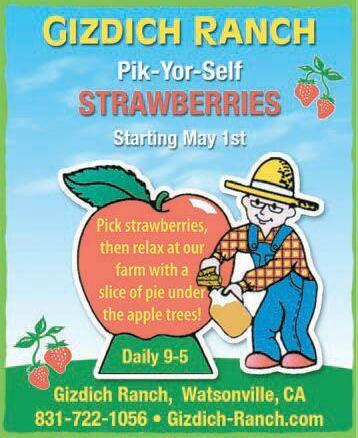
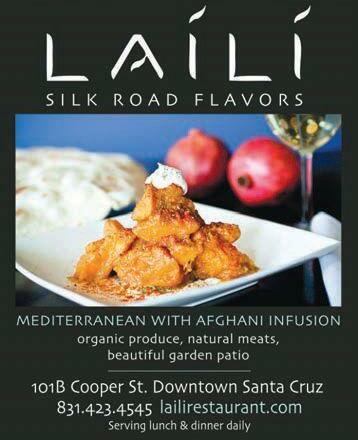
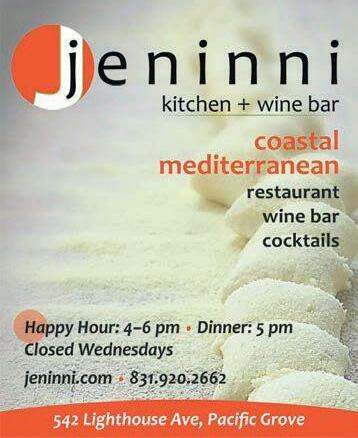

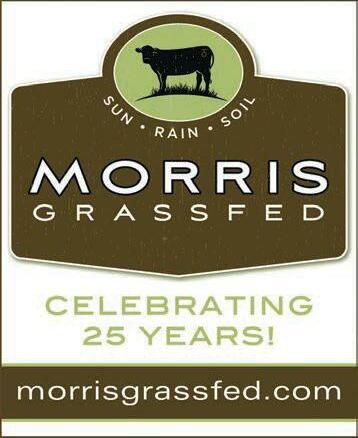


62 edible MONTEREY BAY SPRING 2018 MONTEREY BAY MARKETPLACE • MONTEREY BAY MARKETPLACE
e Picnic Basket

125 Beach Street • 831.427.9946

www.thepicnicbasketsc.com

Across the street from the main beach, owners of e Penny Ice Creamery have opened an alternative to boardwalk fast food. Sandwiches, organic salads, coffee and beer, all from local food artisans, and of course Penny’s popular ice cream, are all on offer to eat in or outside with your feet in the sand. Open daily 7am–4pm. Expanded hours some weekends and holidays.
Rosie McCann’s


1220 Pacific Avenue • 831.426.9930 www.rosiemccanns.com
No typical Irish pub, Rosie’s emphasizes organic, local ingredients in its traditional Irish dishes like lamb stew, shepherd’s pie, corned beef and cabbage and fish and chips, as well as its California specialties such as grassfed burgers, coriander wild salmon, salads and fish tacos. Expect dozens of beers on tap—including local selections. All desserts are made in house, so save room for the Guinness-Ghirardelli chocolate cake. Open M–F for lunch 11:30am–4pm; dinner 4–10pm. Open Sa–Su for brunch 9:30am–2pm; dinner 2–10pm.
Soif Restaurant and Wine Bar
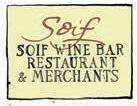
105 Walnut Avenue 831.423.2020 • www.soifwine.com


Inspired by the offerings from local farmers and provisioners, Soif’s cuisine shows California flair with super, seasonal dishes, all paired with local and exotic wines (and a great burger!). A cozy, new bar offers cocktails in addition to the best wine selection in town. e bottle shop next door provides a world-class selection of wines and a welcoming seating area for sipping and tasting. Raw oysters and live jazz every Monday. Open Su– 5–9pm, F–Sa 5–10pm. Wine bar opens noon Tu–Sa, 5pm Su–M.
West End Tap & Kitchen 334D Ingalls Street • 831.471.8115 www.westendtap.com

At West End, perfect for any parent who is looking for a happy hour to satisfy the whole family, adults and kids alike can’t get enough of the duck fat popcorn, fried calamari and flatbread pizzas. A diverse, season-driven menu with offerings like rainbow trout with roasted trumpet mushrooms, and an even longer list of craft beers, ciders and wine options make West End a Westside staple. e outdoor patio is perfect for people watching amidst the bustling Swift Street Courtyard. Open Su– 11:30am–9:30pm, F–Sa 11:30pm–10pm.
SCOTTS VALLEY
Kitchen Table/1440 Multiversity 800 Bethany Drive • 844.544.1440 www.1440.org
1440 is the number of minutes in each day, and at the new learning destination in Scotts Valley, 1440 represents the many opportunities there are to be mindful in this life we live. at philosophy certainly translates to the food we choose to eat, which makes the onsite Kitchen Table a wonderful canvas for showcasing the vibrant, healthful and delicious ingredients we have available locally. Chef Kenny Woods, who came here from Arizona to be part of this unique project, brings an intensive and enthusiastic culinary background to creating plant-based menus that change with every meal, every day, for the diverse, global community that gathers here. Registration for a 1440 program, personal getaway or special event is required to dine at Kitchen Table.
www.ediblemontereybay.com 63
SEASIDE
Gusto
1901 Fremont Boulevard 831.899.5825 www.gustopizzeriapasta.com
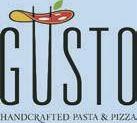
Gusto owner Denis Boaro, owner of Carmel’s Basil Seasonal Dining and a native of Northern Italy, named the restaurant for the Italian word for taste and his enthusiasm for delivering delicious authentic Italian food and great service that can be seen in the happy faces of his diners. e bright red-tiled, wood-fired oven just inside the entrance sets the restaurant’s festive tone, making you feel like you are in Italy. Gusto specializes in fresh pastas, pizzas, housemade mozzarella as well as unique desserts using the best quality ingredients and organic flours from Italy. Our team strives to support local organic farmers, foragers and fishermen bringing you fresh, tasty and sustainable ingredients. Open daily 11:30am–2:30pm, 4:30–9pm.
e Meatery
1534 Fremont Boulevard. • 831.656.8810 www.themeatery.us
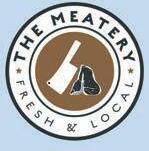
Meat-loving chef-owners Jason Balestrieri and Kevin Hincks have teamed up to create Monterey County’s first modern, artisanal butchery where in addition to selling cuts of sustainably and humanly raised meats and housemade charcuterie to bring home, they also offer deli sandwiches and other prepared foods to eat around a communal table right in the shop. Catering for any occasion also available. Open daily 11am–7pm.
WATSONVILLE
Gizdich Ranch 55 Peckham Road 831.722.1056 | gizdich-ranch.com

Visitors from great distances love this third-generation, family-run farm business that popularized the “pik-yorself” experience just east of Watsonville’s Interlaken neighborhood. Tour the farm, pick fresh apples or berries or watch the action inside the juice-pressing barn. No one leaves hungry if they spend time at the bakery-deli that pleases with its fresh pies, shortcakes and pastries, along with hearty sandwiches and box lunches. is family friendly experience is also a treat for kids, who will enjoy the wide-open spaces and the homemade popsicles. Open daily 9am–5pm.
Hidden Fortress Coffee

125 Hangar Way, Suite 270 831.228.1400 • www.hiddenfortressfarm.com



A farmers’ market favorite now has its own café just two minutes off of Highway 1 in Watsonville. Owner Amelia Loftus serves up house-roasted, organic coffee and bagged beans to go, sourced from small-scale family farms in the best coffee-growing regions around the world. is low-key, charming café also sells local and organic baked goods, housemade seasonal smoothies, yogurt parfaits, salads, sandwiches and local chef-prepared soups. Open M–F 6:30am–3:30pm. Closed Sa and Su.

64 edible MONTEREY BAY SPRING 2018








www.ediblemontereybay.com 65












Spring 2018 LOCAL SOURCE GUIDE
Find the Monterey Bay’s best local, seasonal and sustainable products and services here. ese business advertise in Edible Monterey Bay, supporting our mission and enabling us to provide this magazine to you for free. Please thank them with your business and tell them we sent you!


APPAREL
Madrigal

Carmel Plaza, Mission between Ocean and 7th, Carmel-by- the-Sea | 831.624.3477

Offering attire for men and women who prefer a classic look.
Pacific Trading Co.
1224 Pacific Ave., Santa Cruz | 831.423.3349

504C Bay Ave., Capitola | 831.476.6109 facebook.com/pages/pacific-trading-co/65027935549
Independent, local, family-owned women’s apparel boutique.
ART GALLERIES & HOUSEWARES

Annieglass


310 Harvest Drive, Watsonville 831.761.2041 x21 | annieglassstore.com
Locally designed and handmade slumped-glass plates, bowls and serving dishes that add famed art and style to the dining room.
BANKS AND CREDIT UNIONS
Santa Cruz County Bank sccountybank.com
7775 Soquel Drive, Aptos | 831.662.6000


819 Bay Ave., Capitola | 831.464.5300

720 Front St., Santa Cruz | 831.457.5000
4604 Scotts Valley Drive, Scotts Valley | 831.461.5000
595 Auto Center Drive, Watsonville | 831.761.7600
A leading community business lender and full-service bank of choice for locals.
BARS, BREWERIES AND TAPROOMS
515 Kitchen & Cocktails
515 Cedar St. | 831.425.5051
515santacruz.com
is downtown Santa Cruz rooftop destination for exception craft cocktails also offers a downstairs wine bar and a full dining menu in both locations.
East End Gastropub 1501 41st Ave., Santa Cruz 831.475.8010 | eastendgastropub.com
Local gastropub serving handcrafted food, beer and wine.
Peter B’s Brewpub
2 Portola Plaza, Monterey 831.649.4511 | portolahotel.com
Monterey’s first craft brewery features delicious, locally brewed beer and an innovative menu including vegetarian and gluten-free options.
Santa Cruz Mountain Brewing 402 Ingalls St., Ste. 27, Santa Cruz 831.425.4900 | santacruzmountainbrewing.com
An award-winning, certified-organic craft brewery featuring wildly imaginative seasonal beers, hard ciders, draught root beer and kombucha.
Trailside Café and Beer Garden
3 Del Fino Place, Carmel Valley 831.298.7453 | trailsidecafecv.com
Café and beer garden with handcrafted food and a rotating draft selection of 15 beers and one cider plus over 40 bottled selections including Belgian, German and ciders.
West End Tap & Kitchen 334D Ingalls St., Santa Cruz 831.471.8115 | westendtap.com
Local gastropub serving handcrafted food, beer and wine.
CATERING
an epicurious lifestyle 104 Bronson St., Ste. 13, Santa Cruz 831.588.7772 | anepicuriouslifestyle.com
An epicurious lifestyle is an event-based commercial kitchen and dining space in Santa Cruz.
Aqua Terra 529 Central Ave., Pacific Grove 831.657.9790 | aquaterraculinary.com
Fresh and seasonal food ideas, rooted in sustainability.
Carmel Private Chef - Chef Christophe Bony and Kelley Lefmann
831.251.0168 | info@carmelprivatechef.com

Chef Christophe works with each client’s unique needs, creating menus with local, organic ingredients with utmost quality and integrity and providing in-home meal prep, private parties, cooking classes for groups or individuals. Restaurant consulting and gift certificates available.
e Poke Lab
475 Alvarado St., Monterey 831.200.3474 | thepokelab.com
Food truck and other catering formats serving fresh, locally sourced poke bowls.
DESIGNERS

Dina Clark Design 831.466.9843 | dinaclarkdesign.com
A Central Coast graphic design studio for logos, labels, illustrations and websites.

EDUCATION
Monterey Peninsula College Hospitality Program 831.646.4123 | mjansen@mpc.edu
e MPC Hospitality Program, chaired by Molly Jansen, offers students an opportunity to earn a certificate, associate’s degree or credits for transfer to a fouryear institution to pursue a rewarding career in culinary arts and hospitality.
www.ediblemontereybay.com 67
Camp Vintage Antique Show
Saturday June 9th 8am–4pm
Earthbound Farm’s Farm Stand 7250 Carmel Valley Rd., Carmel Valley info@campvintage.com | FB: @campvintage Cool vintage kitchen gear and farmhouse treasures will be among the finds at this must-attend event for antique lovers; the reopened Farm Stand will offer breakfast and lunch items.
FARMS, RANCHES, CSAS AND CFSS
Gizdich Ranch
55 Peckham Road, Watsonville 831.722.1056 | gizdich-ranch.com
A third-generation farm and bakery-café specializing in heirloom apples, berries, juice and pie.
Live Earth Farm 831.763.2448 | liveearthfarm.net
Watsonville based, with a new farm stand 10am–3pm on weekends at 1275 Green Valley Road and CSA pickup throughout the Monterey Bay and South Bay regions. Committed to sustainable food through a CSA, farmers’ markets and on-farm farm stand and education.
Morris Grassfed Beef CSM, at markets and online 831.623.2933 | morrisgrassfed.com
A provider of locally grown grassfed beef, fostering healthy relationships between people, land, animals and food.
GREEN PRODUCTS AND SERVICES


Blade Tech 831.917.1330 | bladetechusa.com
Professional knife sharpening services for business and home kitchen; also offering high-quality knives and accessories for purchase.
MRWMD 14201 Del Monte Blvd., Marina 831.384.5313 | mrwmd.org
Provides local businesses recycling and a chance to convert food scraps into green energy and compost through its Organics to Energy Program; offers consumers recycling services, workshops and home composting supplies.
Sambrailo Packaging
800 Walker St., Watsonville 831.724.7581 | sambrailo.com
Packaging solutions from our hands to your farm.

Solar Technologies 705 N. Branciforte Ave., Santa Cruz 831.421.0440 | solartechnologies.com
Local solar energy system provider featuring efficient technology, design and installation for your home or business.

HEALING AND WELLNESS
1440 Multiversity 800 Bethany Drive, Scotts Valley 844.544.1440 | 1440.org
e nation’s newest immersive learning center located among the ancient redwoods on a 75-acre campus. Join us for personal growth, professional development, and health and wellness.
Acubloom 833 Cass St., Monterey 831.383.9652 | acubloom.com
Healing simply, simply healing with Kristan Roth, a healer with more than 20 years of experience in acupuncture and a number of other modalities.

La Vie 101 Kennedy Drive, Capitola
831.316.0875 | drinklavie.com
Small batch probiotic wellness drinks, juice cleanses, and almond milks available online and locally at La Vie’s Capitola Tasting Room and Santa Cruz farmers’ markets.

Woman’s Wellspring



Stephanie Taylor, M.D., Ph.D. 26365 Carmel Rancho Blvd., Ste. F, Carmel 831.622.1995 | womanswellspring.com
A new approach to health care based on personal and community wellness.
HOME IMPROVEMENT/REUSE STORES
Habitat for Humanity/ReStore
4230 Gigling Road, Seaside 831.899.1362 | habitatsc.org
719 Swift St., Santa Cruz | 831.824.4704 | habitatsc.org
A nonprofit home improvement store and donation center offering new and gently used furniture, home accessories, building materials and appliances to the public. Proceeds build affordable homes, community and hope locally.
Last Chance Mercantile/MRWMD
14201 Del Monte Blvd., Marina 831.264.6900 | mrwmd.org
A convenient drop-off location for reusable goods that also offers an ever-changing array of affordable, preowned and salvaged items for purchase.
HOTELS AND RESORTS
L’Auberge Carmel
Monte Verde Street and 7th Avenue, Carmel-by- theSea 831.624.8578 | laubergecarmel.com
A romantic, full-service boutique, Relais & Chateau hotel is within walking distance of all that Carmel-bythe-Sea has to offer, including the iconic Carmel Beach.
Bernardus Lodge & Spa
415 W. Carmel Valley Road, Carmel Valley 831.658.3400 | bernarduslodge.com
Located in the heart of sunny Carmel Valley, Bernardus Lodge & Spa is an elegant and intimate luxury resort offering renowned dining and spa experiences and a 10acre on-site estate vineyard.
Hyatt Regency Monterey
1 Old Golf Course Road, Monterey 831.372.1234 | monterey.hyatt.com
Located on Del Monte Golf Course amid 22 beautiful acres of Monterey pines, this hotel also offers a spa and close proximity to Monterey Airport and the city center.
InterContinental e Clement Monterey 750 Cannery Row, Monterey 831.375.4500 | ictheclementmonterey.com e premier luxury hotel in the heart of Cannery Row, situated right next to the Monterey Bay Aquarium and overlooking the pristine Monterey Bay National Marine Sanctuary.
Monterey Plaza Hotel & Spa

400 Cannery Row, Monterey 831.920.6710 | montereyplazahotel.com
At Monterey Plaza Hotel & Spa you’ll be able to enjoy the best of Northern California such as the Monterey Bay Aquarium, historic downtown Monterey and Fisherman’s Wharf, world-class golfing at Pebble Beach, shopping in Carmel, wine tasting in Carmel Valley and the memorable Big Sur coastline.
Pebble Beach Resorts 17-Mile Drive, Pebble Beach 866.935.6341 | pebblebeach.com
Stunning views, legendary golf, diverse and exceptional cuisine and luxury accommodations are all part of the world-renowned Pebble Beach experience.
68 edible MONTEREY BAY SPRING 2018
Portola Hotel & Spa
2 Portola Plaza, Monterey 831.649.4511 | portolahotel.com
A relaxing retreat in historic Monterey surrounded by unique shopping, fine dining, spectacular coastal trails and beaches.
Post Ranch Inn/Sierra Mar Restaurant
47900 Hwy. 1, Big Sur 831.667.2800 | postranchinn.com
A “sanctuary for the soul” offering the ultimate in luxurious coastal Big Sur lodging, including breathtaking views and exquisite dining.
Quail Lodge & Golf Club
8000 Valley Greens Drive, Carmel 831.620.8808 | quaillodge.com
Quail Lodge features comfortable lodging, an 18-hole championship golf course, fitness center and sustainably sourced, seasonal cuisine on the Monterey Peninsula.
MEDIA
90.3 KAZU
100 Campus Center, Building 201, Room 317, Seaside 831.582.5298 I kazu.org
Public radio for the Monterey Bay area.
KZSC Santa Cruz, 88.1FM 831.459.2811 | kzsc.org
College radio broadcasting from UC Santa Cruz. Tune in for music, news, public affairs, sports, and more!
NURSERIES, LANDSCAPING AND GARDEN SUPPLIES


DIG Gardens
420 Water St., Santa Cruz 831.466.3444 | diggardensnursery.com
A garden shop unlike any other: organic, bohemian, modern style from Santa Cruz.
Gardner & Bloome
OMRI-listed organic fertilizers and soils from Kellogg Garden Products distributed locally by:
Aptos Landscape Supply
5035 Freedom Blvd., Aptos 831.688.6211 | aptoslandscapesupply.com
Del Rey Oaks Gardens
899 Rosita Road, Del Rey Oaks 831.920.1231 | drogardens.com
Drought Resistant Nursery 850 Park Ave., Monterey 831.375.2120 | droughtresistant.com
e Garden Co. 2218 Mission St., Santa Cruz 831.429.8424 | thegardenco.com
Griggs Nursery 9220 Carmel Valley Road, Carmel 831.626.0680 | griggsnursery.com
Hidden Gardens Nursery
7765 Soquel Dr., Aptos 831.688.7011
Lakeside Nursery
190 Espinosa Road, Salinas 831.632.2100 | lakesidenursery.net
J. Murphy Lumber
10 E. Carmel Valley Road, Carmel Valley 831.659.2291 | facebook.com/m.j.murphylumberhardware
Martins’ Irrigation
420 Olympia Ave., Seaside 831.394.4106 | martinsirrigation.com
McShane’s Landscape Supply
115 Monterey Salinas Hwy., Salinas 831.455.1876 | mcshaneslandscape.com
Mountain Feed & Farm 9550 Hwy. 9, Ben Lomond 831.336.8876 | mountainfeed.com
Plant Works 7945 Hwy. 9, Ben Lomond 831.336.2212
San Lorenzo Garden Center 235 River St., Santa Cruz 831.423.0223 | sanlorenzolumber.com/gardencenter
Scarborough Gardens 33 El Pueblo Road, Scotts Valley 831.438.4106 | scarboroughgardens.com
Seaside Garden Center 1177 San Pablo Ave., Seaside 831.292.0400 | seasidegardencenter.com
Valley Hills Nursery 7440 Carmel Valley Road, Carmel 831.624.3482 | valleyhillsnursery.net
MRWMD



14201 Del Monte Blvd., Marina 831.384.5313 | mrwmd.org
Provider of premium-quality, OMRI-listed organic compost as well as topsoil and wood chips by the truckload at the district scales or bag-your-own at the on-site Last Chance Mercantile shop.
Plant Landscape Design 2801 S. Main St., Soquel 831.476.1895 | plantlandscapedesign.com
Full-service landscaping company: design, build, maintain, serving greater Monterey Bay.
Terra Nova Ecological Landscaping Santa Cruz | 831.425.3514 | terranovalandscaping.com
A full-service ecological landscaping company providing design, installation and maintenance of beautiful living systems for public and private lands.
REAL ESTATE
Courtney G. Jones/Carmel Realty Co. Dolores Street between 7th and 8th Avenues 831.233.4839 | courtneygjones.com Courtney@carmelrealtycompany.com
Family-owned firm offering local luxury real estate experts with a reputation for integrity, longevity and excellence.
RECREATION
Chardonnay Sailing Charters


704 Soquel Ave., Santa Cruz 831.423.1213 | chardonnay.com
Excursions aboard the Chardonnay II are perfect for any age group and fun for everyone from seasoned sailors to first-time adventurers.
RESTAURANTS AND CAFÉS
See our Dine Local Guide, p. 53.



SPECIALTY FOOD AND DRINK PURVEYORS
Big Sur Salts PO Box 546, Big Sur bigsursalts@gmail.com | bigsursalts.com Craft salts that bring the color, tastes and aromas of Big Sur to you.
www.ediblemontereybay.com 69












Food Lounge
1001 Center St., Santa Cruz scfoodlounge.com
A dynamic community venue for food, art and entertainment; also available for private events, meetings, fundraisers and parties.
e Meatery
1534 Fremont Blvd, Seaside 831.656.8810 | themeatery.us
A friendly and modern chef-owned and run artisanal butchery providing housemade charcuterie, sustainably and ethically raised meats as well as sandwiches and other prepared foods to eat in or take out. Catering also available.
Monterey Farms
1354 Dayton St., Ste. I, Salinas 831.757.7297 | montereyfarmsartichokes.com

Small, locally owned and operated producer of fresh prepared artichoke hearts for use by chefs and home cooks.
e Quail & Olive
3 Pilot Road, Carmel Valley 831.659.4288 | quailandolive.com
A boutique featuring quality, California olive oils and vinegars, as well as natural skin care products and cookbooks for better health.
Santa Cruz Community Farmers’ Markets 831.454.0566 | santacruzfarmersmarket.org
Lincoln and Cedar streets, Santa Cruz 21511 E. Cliff Drive, Live Oak 2801 Mission St., Santa Cruz 120 Russell Ave., Felton
Scotts Valley Community Center, Scotts Valley
For more than 25 years Santa Cruz Community Farmers’ Markets (SCCFM) has been committed to your health and to the health of the local economy.
Shopper’s Corner 622 Soquel Ave., Santa Cruz 831.423.1398 | shopperscorner.com
Santa Cruz’s oldest and friendliest family-run market.
Star Market
1275 S. Main St., Salinas 831.422.3961 | starmkt.com
An independent grocer featuring the freshest, best tasting and finest selection of food in the Monterey Bay area; locally produced foods and wines are a specialty.
Stewart & Jasper Orchards
Monterey Plaza Hotel 400 Cannery Row, Ste. C, Monterey 831.375.6887 | stewartandjasper.com



A family-owned almond grower committed to quality, eco-friendly practices, water conservation and customer service.
Troia Foods


801 Foam St., Monterey 831.375.3354 | troiafoods.com
A local dairy and fine food distributor for businesses.




Vertigo Coffee Roasters
81 Fourth St., San Juan Bautista 831.623.9533 | vertigocoffee.com
Specialty coffee roasters that also feature wood-fired cooking and craft beers.
TRAVEL
Monterey County Convention & Visitors Bureau





401 Camino El Estero, Monterey 888.221.1010 | seemonterey.com
Tourism information for Monterey County.
WINERIES AND TASTING ROOMS
Cima Collina Tasting Room
19 E. Carmel Valley Road, Carmel Valley 831.620.0645 | cimacollina.com
Award-winning, artisanal wines from small Monterey vineyards. Tasting room is located in a picturesque historic building.
McIntyre Tasting Studio 169 Crossroads Blvd., Carmel 831.626.6268 | mcintyrevineyards.com Small lot wines that embody the mountainous, maritime terroir.
Scheid Vineyards Tasting Room
San Carlos at 7th, Carmel-by-the-Sea 831.626.WINE | scheidvineyards.com
Scheid Vineyards Winery & Tasting Room 1972 Hobson Ave., Greenfield 831.386.0316 | scheidvineyards.com
Forty years of success in family winemaking in Salinas Valley.
Talbott Vineyards 25 Pilot Road, Carmel Valley 831.659.3500 | talbottvineyards.com
Enjoy renowned, award-winning pinots and chardonnays on the sunny terrace or spacious interior of Talbott’s tasting room in the heart of beautiful Carmel Valley.
Want to see your service or product listed here? Email us for more about how we can help you promote your business and build your brand at ads@ediblemontereybay.com.
www.ediblemontereybay.com 71


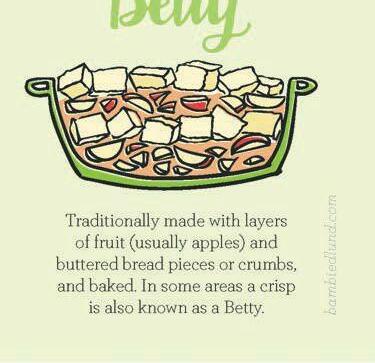
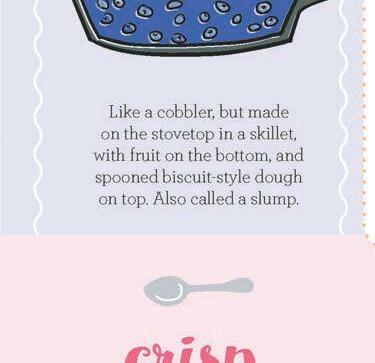






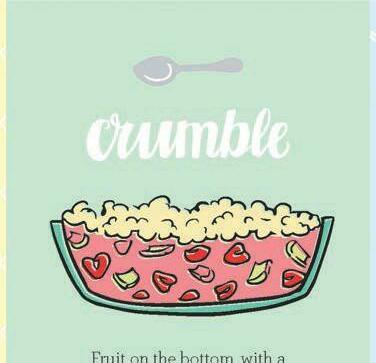
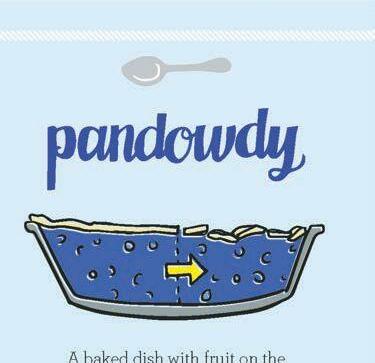
72 edible MONTEREY BAYSPRING 2018 LAST CALL
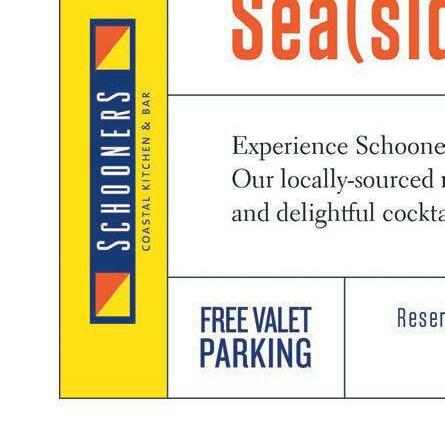




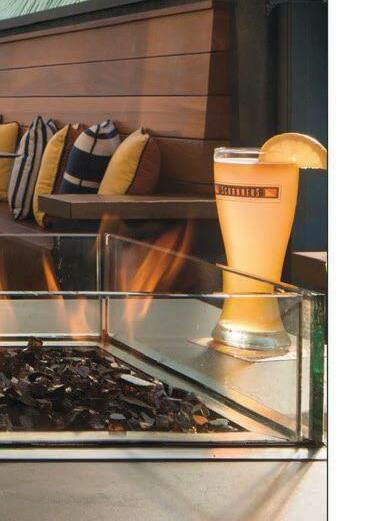

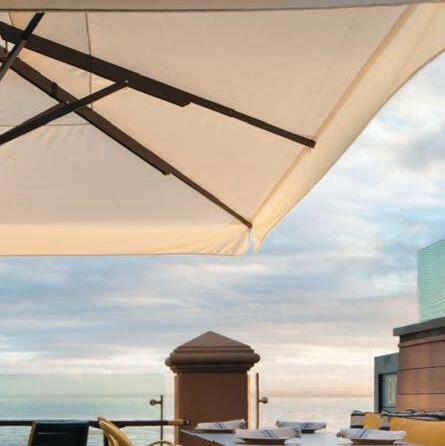






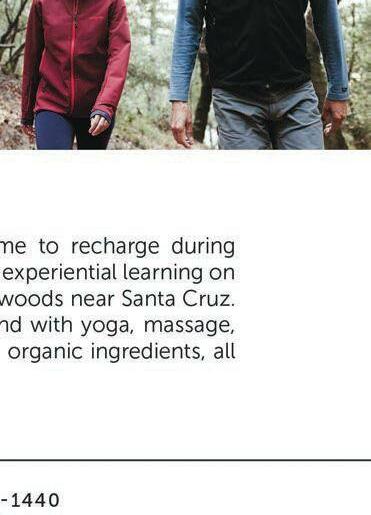

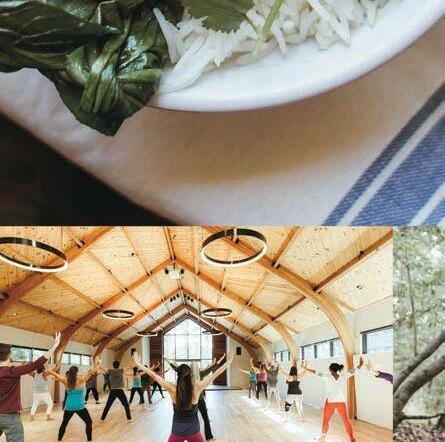

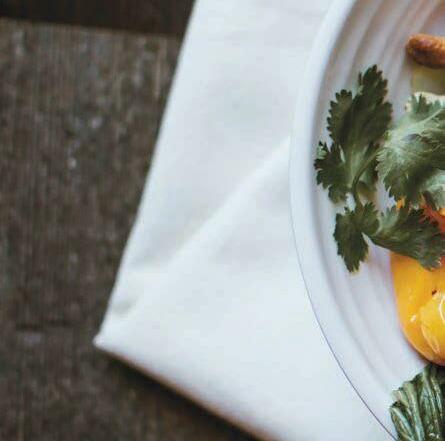

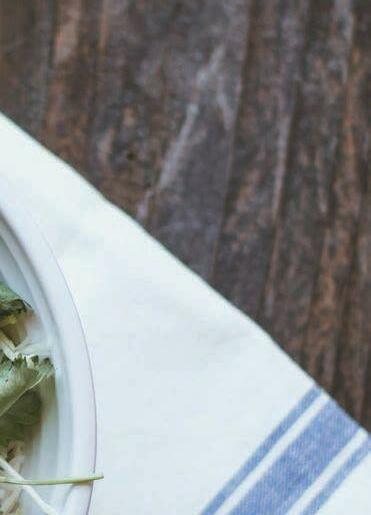



















































































 BY LILY STOICHEFF
BY LILY STOICHEFF








 BY WALLACE BAINE PHOTOGRAPHY BY REBECCA GOUREVITCH AND JAKE THOMAS
BY WALLACE BAINE PHOTOGRAPHY BY REBECCA GOUREVITCH AND JAKE THOMAS





































































































































































































































































































 BY ANINA MARCUS PHOTOGRAPHY BY MICHELLE MAGDALENA AND PAUL FUSCO
BY ANINA MARCUS PHOTOGRAPHY BY MICHELLE MAGDALENA AND PAUL FUSCO























 BY KATHRYN MCKENZIE
BY KATHRYN MCKENZIE




































































































































































































































































































